- THE PRINCESS PASSPORT
- Email Newsletter
- Yacht Walkthroughs
- Destinations
- Electronics
- Best Marine Electronics & Technology
- Boating Safety

- Cruising and Chartering

Freshwater Systems for Yachts
- By Dudley Dawson
- Updated: May 17, 2011
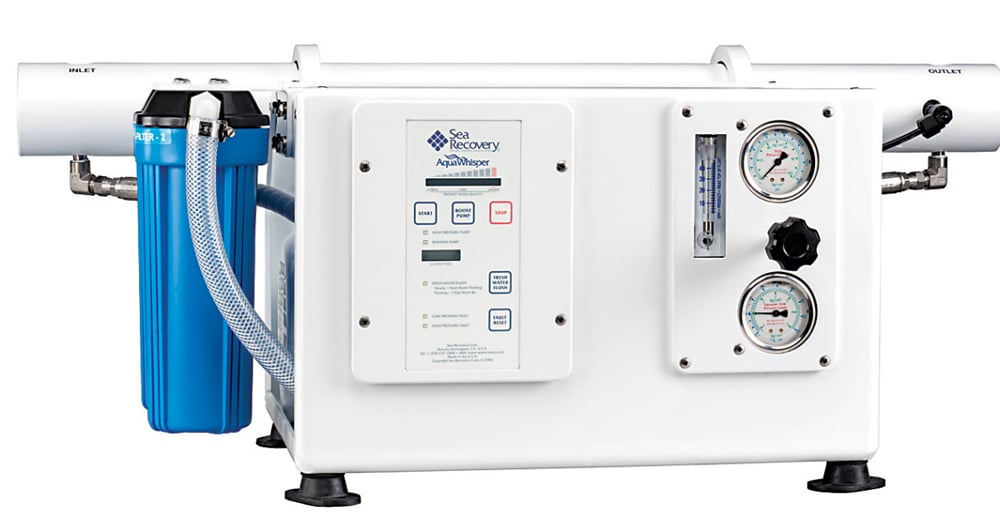
Freshwater Systems
As far as I know, neither Ben Franklin nor Rowland Howard were yachtsmen, but Howard spoke to a yachting issue when he paraphrased Franklin to observe that “you never miss the water till the well runs dry.” We, of course, have a water tank or two aboard rather than a well, but the point’s the same. We take a good, continuous supply of fresh water for granted aboard modern cruising yachts, and we sometimes don’t think much about the freshwater systems until we are forced to choose between taking a shower or cooking the pasta.
Freshwater systems are relatively straightforward and not too difficult to maintain if you understand a few basics. On small boats , a system can be as simple as a tank and a pump that comes on when a faucet is opened. Systems on most yachts, though, are a little more involved. They consist of one or more tanks, often with level monitors, feeding through a sediment filter to a pressure pump. The pump charges an accumulator (bladder) tank to maintain pressure without continuously running the pump. The pipe or hose from the accumulator then feeds to a manifold to supply cold water directly to the toilets, showers, tubs, lavatories, galley sinks and ice makers. It also feeds to a water heater, fitted with a temperature/ pressure relief valve for safety, to supply hot water to the showers, tubs and sinks. On larger yachts, there may be a connection to the washdown hoses and even to the firefighting system to avoid the damage that would result from spraying salt water inside the yacht in the event of a small fire.
The freshwater systems on yachts are potable; that is, both the water and the system’s components with which it comes into contact must meet the standards for drinking-water quality. In the United States, these are set by the Food and Drug Administration (FDA), so look for tanks, hoses and fittings made with FDA-approved materials, and always use such components when maintaining or repairing the system. This includes the tanks and components downstream, the tank fill and the vent lines, and make sure the vent lines terminate high enough to prevent them from submerging when the yacht rolls or takes a wave. If you’re careful about the water coming into the tank, the system should stay fairly clean, but ultraviolet sterilizers are available if you want to make sure you and your guests are as protected as possible.
Now, I have a bone to pick with current yacht design and construction practices. In my early years as a yacht designer, we put lots of freshwater tank capacity aboard, because only the largest yachts of the day could afford the space, expense and power needed for a steam distillation unit to produce fresh water under way. Then came reverse osmosis (RO) systems, also commonly known as watermakers, and eventually even the smallest yacht could afford one of the compact units to replenish the tanks. As a result, some new yachts have much smaller water tanks than their predecessors had. That, I think, is a mistake, and it came to light for me during an extended cruise on which we did a lot of gunkholing and anchoring. Because the tanks were too small to carry a sufficient supply, we had to run the generator to power the watermaker during periods in pristine anchorages where peace and quiet would have been preferable to the intrusive hum of the generator.
I’d opt for several tanks in ideal freshwater systems, filling only one for day trips, but filling them all for longer cruises, combined with a water maker large enough to recharge the tanks when running only a few hours a day. It’s more expensive but makes for a better cruising plan. Don’t suffer the fate of Samuel Taylor Coleridge’s ancient mariner — “Water, water, everywhere, nor any drop to drink.” Start with a good freshwater system and then maintain it to sustain your lifestyle.
Subscribe to the Yachting Life newsletter for cruising and chartering guides, new boat announcements, event updates, special offers and more!
- More: Cruising & Chartering
- More Cruising and Chartering
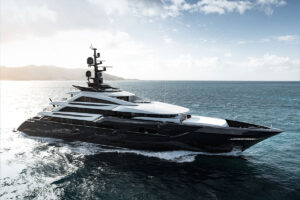
Charter Clients, Start Your Engines
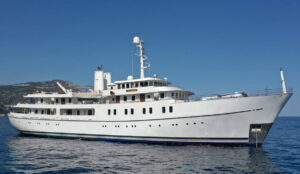
Exotic Yacht Charter Opportunities
Cruising to Key Largo
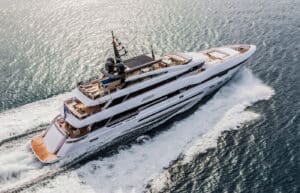
It’s Incentive Season for Charter Yachts
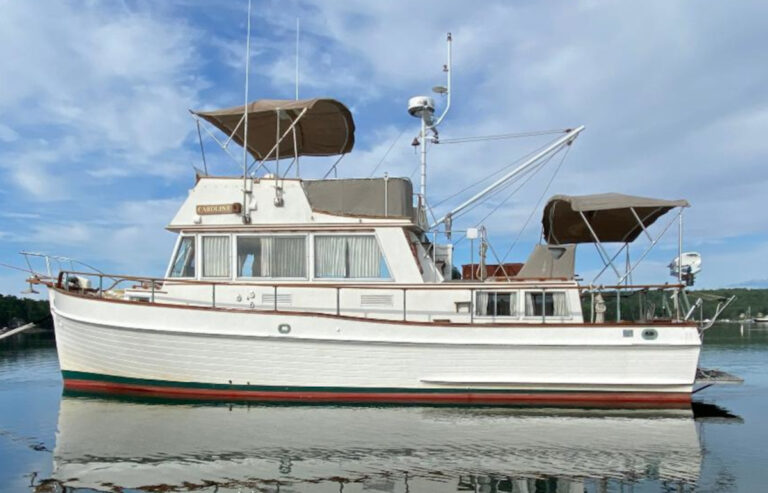
For Sale: Grand Banks 36 Classic
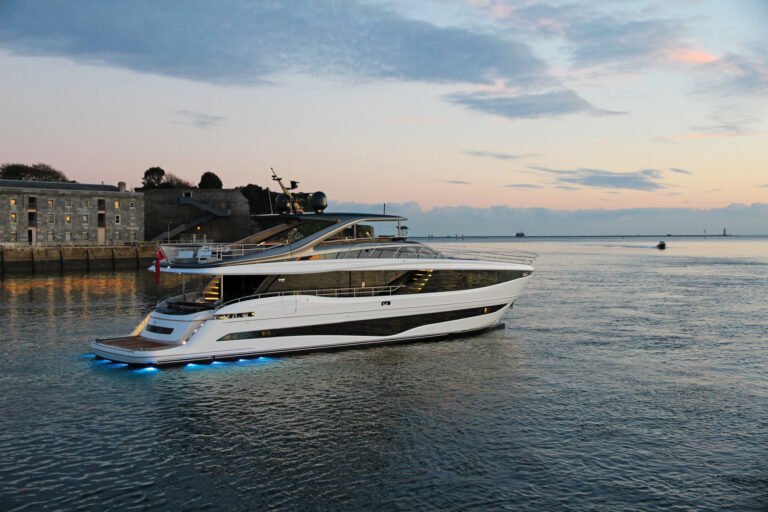
Princess Yachts’ Y95: A Flagship Flybridge
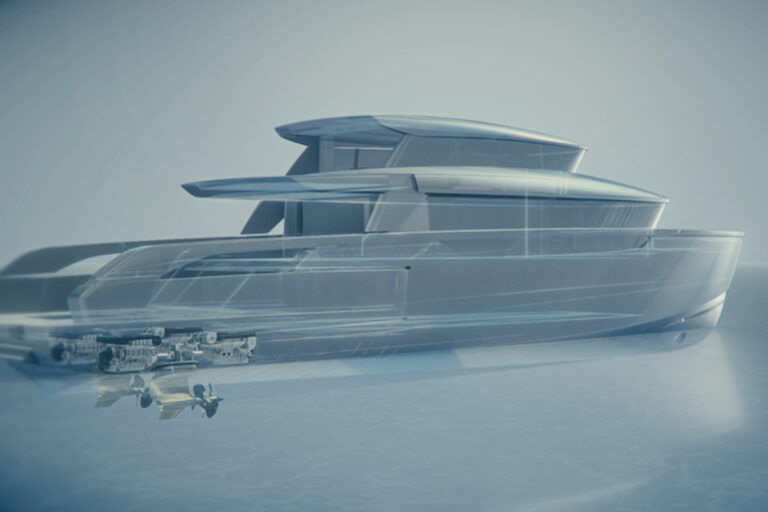
Sanlorenzo, Volvo Penta Announce Partnership
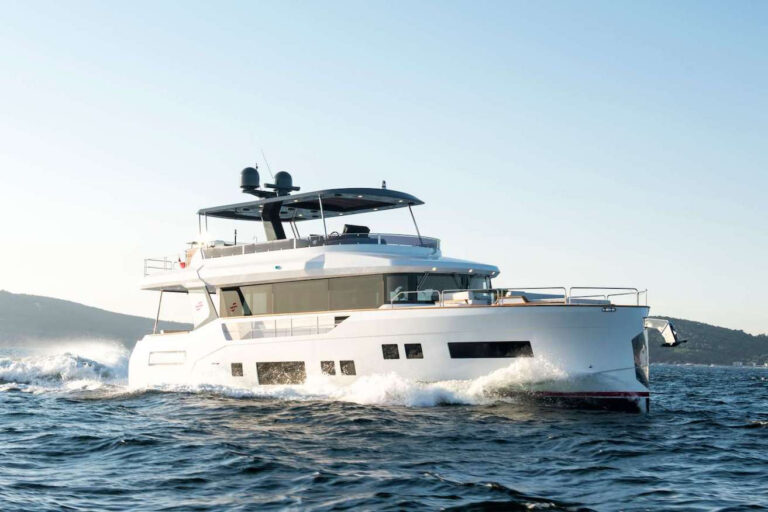
For Sale: 2023 Sirena 68

- Digital Edition
- Customer Service
- Privacy Policy
- Terms of Use
- Email Newsletters
- Cruising World
- Florida Travel + Life
- Sailing World
- Salt Water Sportsman
- Sport Fishing
- Wakeboarding
Many products featured on this site were editorially chosen. Yachting may receive financial compensation for products purchased through this site.
Copyright © 2024 Yachting. A Bonnier LLC Company . All rights reserved. Reproduction in whole or in part without permission is prohibited.

How Yachts Get Fresh Water | Essential Guide
Fresh water is a vital resource for any yacht, providing hydration, cleanliness, and comfort for those on board. Yachts employ various systems and technologies to ensure a reliable supply of fresh water, whether cruising in open waters or docked in a marina.
So, how do yachts get fresh water ? Let’s explore the different methods and systems that yachts use to obtain and maintain a clean and safe water supply.
Key Takeaways:
- Yachts rely on water purification, desalination, and filtration systems to obtain fresh water
- Water can be sourced from onboard storage tanks, shore connections, or produced on board using advanced technologies like watermakers
- Yachts have freshwater storage tanks and distribution systems to ensure a consistent supply of fresh water throughout the yacht
- Water purification systems, such as reverse osmosis, remove salt and impurities from seawater to make it drinkable
- Yachts have multiple options for sourcing fresh water, including shore connections, onboard storage tanks, and watermakers
Freshwater Storage and Distribution Systems on Yachts
Yachts are equipped with efficient freshwater storage and distribution systems to ensure a reliable supply of potable water on board. These systems consist of various components, including yacht water storage tanks , yacht water distribution systems , and yacht water pumps .
Yacht Water Storage Tanks: Yachts feature dedicated freshwater storage tanks that hold the potable water on board. These tanks are specifically designed to store large quantities of water and are typically made of corrosion-resistant materials such as stainless steel or food-grade plastic. The capacity of the storage tanks varies depending on the size and design of the yacht, with larger vessels often having multiple tanks to meet the water demands of the crew and guests.
Yacht Water Distribution Systems: Once the freshwater is stored in the tanks, it needs to be efficiently distributed throughout the yacht. Yachts employ a network of pipes and valves to facilitate the distribution of water to different areas of the vessel. The distribution system ensures that water is readily available at various outlets, including sinks, showers, toilets, and other fixtures. To regulate water flow and pressure, yacht water distribution systems are equipped with control valves that can be adjusted as needed.
Yacht Water Pumps: Yacht water pumps play a crucial role in moving the water from the storage tanks to the different outlets on the yacht. These pumps are available in both electric and manual variants, providing flexibility and convenience. Electric pumps are commonly used on larger yachts due to their higher water flow capacity and automation capabilities. Manual pumps, on the other hand, are suitable for smaller vessels and can be operated manually to control the water flow.
It is essential to use non-toxic and non-contaminating materials for the pipes in the yacht water system. Common materials used include PVC (Polyvinyl Chloride) or PE (Polyethylene) tubing. These materials are durable, resistant to corrosion, and maintain the integrity of the water quality during distribution.
Proper maintenance and regular cleaning of the freshwater storage tanks and distribution system are crucial to ensure a clean and reliable supply of fresh water on the yacht. Regular inspections should be conducted to detect any leaks or damages in the system, and appropriate measures should be taken to rectify them promptly. Additionally, regular sanitization and purification procedures should be implemented to maintain the water quality and prevent the growth of bacteria or other contaminants.
Water Purification and Desalination on Yachts
Yachts often rely on water purification and desalination systems to convert seawater into fresh water. Desalination is the process of removing salt and other impurities from seawater to make it drinkable. One common method used is reverse osmosis, where seawater is forced through a semi-permeable membrane to separate the salt and minerals from the water. This purified water is then stored in the freshwater tanks for use on the yacht. Other water treatment techniques like filtration and UV sterilization may also be used to ensure the water is safe and clean.
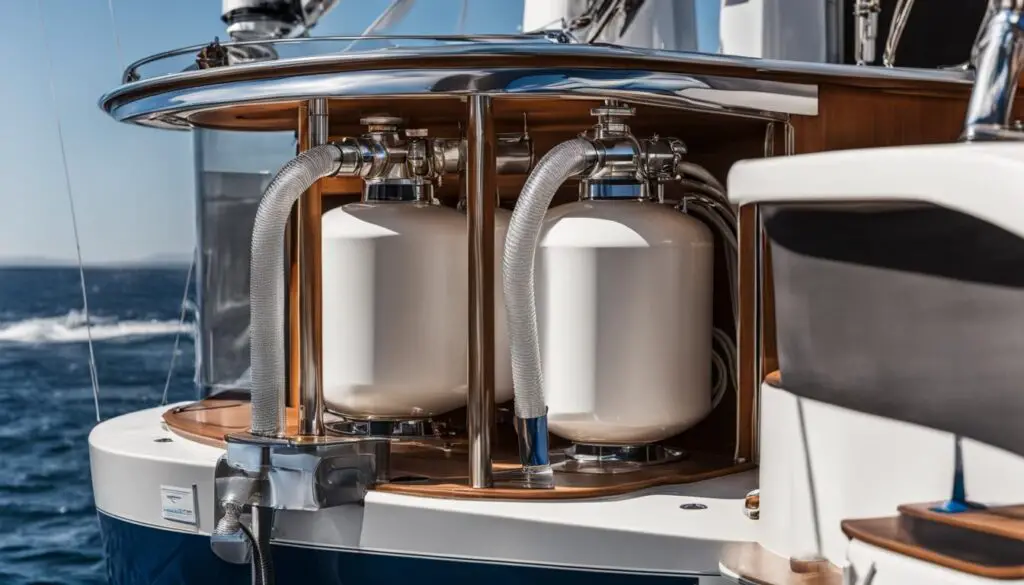
Freshwater Sources for Yachts
When it comes to sourcing freshwater, yachts have a variety of options to ensure a reliable supply. Let’s explore some of the common methods that yachts use to obtain fresh water.
Shore Connections: Convenient and Reliable
One of the most convenient and reliable sources of freshwater for yachts is through shore connections. When docked in a marina, yachts can connect to a municipal water supply, allowing them to fill their onboard storage tanks with potable water. This ensures a ready supply of freshwater for drinking, cleaning, and other onboard needs.
Onboard Storage Tanks: Carrying Your Own Supply
Yachts also have the option to carry their own supply of freshwater in onboard storage tanks. These tanks are filled through shore connections or by using advanced technologies like watermakers. By having their own supply onboard, yachts can maintain self-sufficiency even in remote locations where shore connections may not be readily available.
Watermakers: Producing Freshwater from Seawater
Watermakers are a popular choice for yachts, as they allow the production of freshwater from seawater. These systems use advanced technologies like reverse osmosis to remove salt and impurities from seawater, resulting in clean and drinkable freshwater. The produced freshwater is then stored in the onboard tanks for use on the yacht.
Rainwater Collection: An Alternative Source
While less common, some yachts may also collect rainwater as a freshwater source. Rainwater can be captured and stored in dedicated tanks, and then treated and filtered before it is considered safe for use. This alternative source of freshwater can be particularly useful in areas where other sources may be limited or unavailable.
Ultimately, the choice of freshwater source for a yacht depends on various factors, including the yacht’s location, duration of stay, and the availability of clean and safe water. By having multiple options available, yachts can ensure a continuous supply of freshwater, enhancing the comfort and enjoyment of those on board.
Ensuring a reliable and clean fresh water supply on a yacht is essential for the comfort and well-being of those on board. Yachts utilize a range of advanced systems and technologies, including water purification, desalination, and filtration, to obtain and maintain a fresh water source. However, it is equally important for yacht owners to practice regular maintenance and effective management of these fresh water systems to ensure the availability of high-quality water on board.
By understanding the different methods and sources of obtaining fresh water, yacht owners can take the necessary steps to maintain their yacht’s fresh water system and ensure a smooth and enjoyable experience on the water. Regular inspections, cleaning, and proper storage of fresh water are key in preventing contamination and maintaining optimal water quality. Additionally, staying updated on the latest advancements in fresh water management practices can help yacht owners make informed decisions regarding the upkeep of their yacht’s water system.
Yachts are equipped with sophisticated technologies like water purification systems, desalination units, and watermakers that enable them to produce and maintain a fresh water supply even in remote locations. These systems, coupled with proper maintenance and the use of approved materials, contribute to the longevity and efficiency of the yacht’s fresh water systems. Yacht owners can consult experts and professionals in the marine industry to acquire valuable insights and guidance on fresh water management practices specific to their vessel.
How do yachts obtain fresh water?
Yachts obtain fresh water through various methods such as water purification, desalination, and filtration. They can source water from onboard storage tanks, shore connections, or produce it onboard using advanced technologies like watermakers.
How do yachts store and distribute fresh water?
Yachts have freshwater storage tanks that hold potable water. Electric or manual pumps are used to move the water from the storage tanks to various outlets like sinks, showers, and toilets, through a system of pipes and pumps.
What is the process of water purification and desalination on yachts?
Water purification and desalination on yachts involve methods like reverse osmosis, where seawater is forced through a semi-permeable membrane to remove salt and other impurities. Additional water treatment techniques like filtration and UV sterilization may also be employed to ensure the water is safe and clean.
What are the freshwater sources for yachts?
Yachts can source freshwater from shore connections when docked in a marina, carry their own supply in onboard storage tanks, or produce it from seawater using watermakers. Some yachts may also collect rainwater for use as a freshwater source.
How can yachts maintain a fresh water supply?
Regular maintenance and proper management of the fresh water systems are crucial to ensure the quality and availability of fresh water on a yacht. This includes cleaning and maintaining storage tanks, filters, and pipes, as well as following best practices for water management onboard.
Source Links
- https://twogetlost.com/fresh-water-on-a-sailboat
- https://starboardyacht.com/how-does-plumbing-work-in-a-yacht/
- https://www.octomarine.net/water-treatment-accessories/a-quick-guide-on-providing-clean-safe-drinking-water-on-marine-vessels.html
Nicholas Finn
I've been the captain of a fishing boat for over 20 years, and I created Pirateering to share my knowledge of and interest in seafaring.
Recent Posts
Carnival Celebration Sailing Dates Unveiled
Are you dreaming of setting sail on the magnificent Carnival Celebration cruise ship? Well, the wait is over! We are thrilled to unveil the sailing dates for the Carnival Celebration, operated by...
Can Shrimp Live with Snails? Aquarium Harmony Tips
When it comes to creating a harmonious aquarium environment, many aquarium enthusiasts wonder if shrimp can live with snails without any issues. Finding compatible tank mates for shrimp is essential...

Home » Blog » Gear » Watermakers: a guide to marine desalinators and making water on a boat
Watermakers: a guide to marine desalinators and making water on a boat
By Author Fiona McGlynn
Posted on Last updated: March 23, 2022
There’s something magical about a watermaker—at least that’s how I felt after we installed one on our boat. That may sound overblown, but think about it: watermakers transform salt water into fresh water, providing a near-endless supply of potable water for drinking, bathing, and cleaning! THAT my friends is an amazing piece of technology!
(If you don’t share my enthusiasm, try going without a shower for a few days and you’ll begin to see my point).
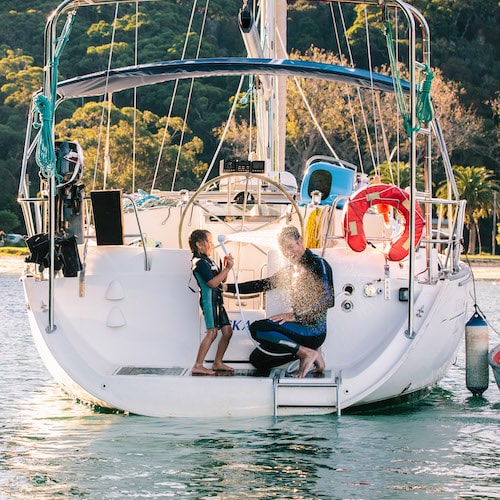
Having experienced living on a boat and cruising, both with and without a marine desalinator, I can attest that it’s a game-changing piece of gear. However, you definitely don’t need one to go cruising. There are plenty of low-tech ways to collect and make water on a boat.
Marine desalinators do offer some major benefits: there’s more water for showers, it’s easier to travel farther afield, you can spend more time in a remote location. However, these benefits have to be weighed against the drawbacks: namely a hefty price tag and ongoing maintenance.
Deciding whether a watermaker is right for you will come down to the type of cruising you’re doing, how much water you need, and your budget. Read on to learn about the pros and cons, costs, and key features of marine watermakers.
Table of contents
- 1 How does a watermaker work?
- 2.1 Benefits
- 2.2 Drawbacks
- 3.1 Powered or handpump
- 3.2 Electric or engine drive
- 3.3 Energy recovery watermaker
- 3.4 Modular, self-contained, and portable watermakers
- 3.5 Automatic flushing systems
- 3.6 Automatic Pressure Regulation and adjustable pump speed
- 3.7 Remote control panels
- 4 Top watermaker brands
How does a watermaker work?
A watermaker on a yacht converts seawater into fresh water through a process known as reverse osmosis (RO). A high-pressure pump pushes seawater through a semi-permeable membrane that filters out salt, organics, and bacteria. The fresh water is pumped into your water tanks while the remaining brine bi-product is discharged over the side of the boat, back into the ocean.
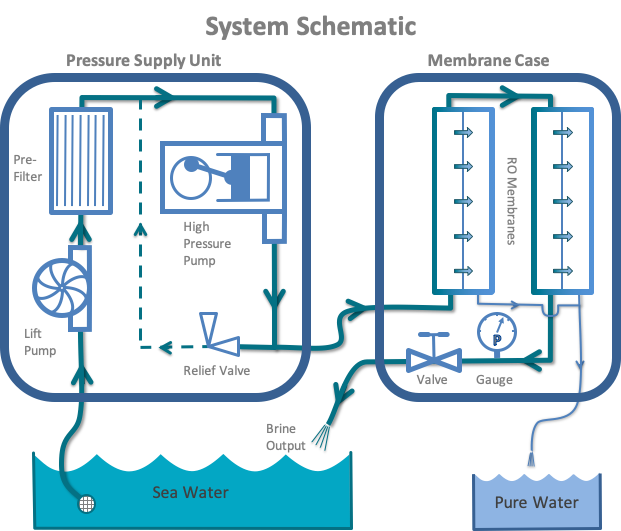
Marine watermakers: the benefits and drawbacks
Less water rationing.
When we started our 13,000 mile trip across the Pacific, we didn’t have a watermaker. We were on a tight budget and decided to prioritize other pieces of equipment like a life raft and wind vane.
As a result, we became experts in conserving water on a boat . We would carefully ration out water for washing dishes, taking showers, and even brushing our teeth!
After getting a watermaker we became far less meiserly because we knew we could always make more water if we needed to. It was a relief to not be constantly thinking about how much water we were using over the course of a day.
That being said, we couldn’t relax completely. We had to keep our tanks topped up, so as not to run the pump dry. We also always carried potable water in reserve, in case our watermaker broke in the middle of a long passage.
More luxuries
Can’t live without a proper shower? A boat water maker can make water-intensive luxuries like freshwater deck washdown, freshwater flushing heads, laundry, daily showers, and even baths, a possibility.
As great as this sounds in theory, we were surprised to find that we didn’t indulge in more showers after we got the watermaker.
We continued to use a hand pump pesticide sprayer to shower on deck despite having a watermaker and shower below. While some of this came down to habit, we also disliked running our engine (and consuming diesel) just to run the watermaker.
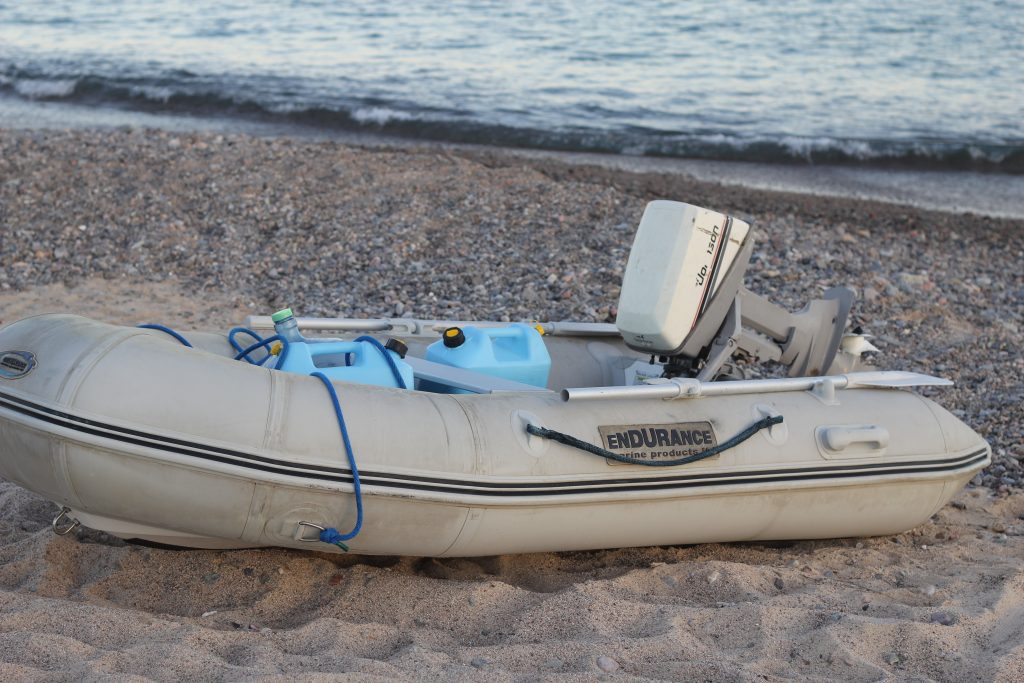
No hauling water
For us, this was by far the greatest benefit of having a watermaker!
While cruising in the US and Canada, we could refill our water tanks at a dock or marina. This was a minor hassle because it involved pulling up the anchor and docking the boat.
In Mexico, it was more challenging to get water. We would fill 5-gallon jugs at the local water purification plant in town and wheel them back to our boat on a collapsible dolly.
It often took a couple of trips with the dolly and dinghy to fill our water tanks. Oh, and we broke our dolly, twice!
We realized that if we wanted to spend more time exploring, and less time hauling water, we would have to invest in a watermaker. When we reached La Paz, Mexico we bought a refurbished watermaker, and we were so glad we did!
Our sailboat water maker gave us the gift of time, especially in places like Mexico and the South Pacific, where there were limited opportunities to fill water tanks up at the docks. It also saved us paying docking and water fees.
We estimate that our boat water maker saved us anywhere from four to six hours every week, time that we could spend exploring the wonderful places we were visiting.
A clean, safe water source
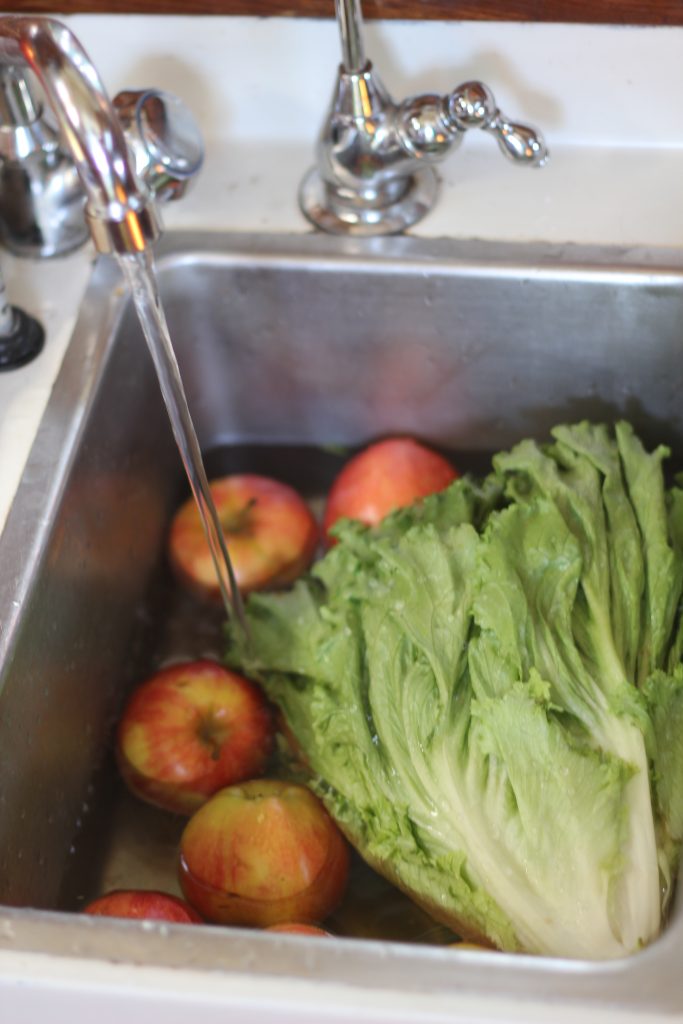
In places where the drinking water may be suspect, a boat water maker can be a reliable source of safe drinking water (assuming it’s in good working condition!).
More time in remote locations
A watermaker is a great tool if you’re drawn to remote locations where you might be the only boat in the anchorage.
It wasn’t until we reached Los Frailes, a secluded village on the Baja, that we really began to think about buying a watermaker.
There we were in an idyllic anchorage, surrounded by spectacular hiking and fishing. There was only one problem—every two days we had to walk 10 miles into town with our water jugs and hope that some kind samaritan would give us a lift back to our boat.
Before having a watermaker, we’d often leave a place we loved just because we needed to fill up our tanks. With a watermaker, we were more self-sufficient and could stay an extra few days, or as long as we wanted!

The number one drawback is the cost. We were able to find a refurbished water desalinator for $3,000, which was a great deal but also a considerable slice out of our cruising kitty.
How much does a watermaker cost?
Powered desalination systems for your average recreational cruising boat range from around 3,500 USD to 11,000 USD, with the more expensive options offering higher production (gallons of fresh water per hour).
Ongoing maintenance
Watermakers are yet another piece of boat equipment that needs to be maintained.
The majority of watermaker problems are caused by not using it enough or not using it properly.
If a watermaker is not used for a few weeks, the planktonic organisms in the seawater will die, rot, and clog the membrane and filters. This can eventually damage the reverse osmosis membrane in the watermaker.
For this reason, boat water makers should be used frequently and regularly flushed with fresh water.
Watermaker flushing
Check your manufacturer’s instructions on how to flush.
Rainman recommends flushing the seawater out of the system with fresh water if you are not using the system for more than a day or two. After another week, you need to freshwater flush the system again or pickle it for long-term storage.
Of course, it’s easy to forget, so we made it a rule to freshwater flush our watermaker after every use.
This is one good reason to choose a watermaker with an output that will meet your water consumption needs but not exceed them. If you’re using it every second day, you won’t have to try and remember whether you’ve flushed it or not.
Flushing a watermaker is relatively simple but it does involve a bit of work. We used a system with buckets of fresh water to flush our system and it generally took about 5 minutes.
You can also buy systems that automatically flush your watermaker at pre-determined times—even when you’re away from the boat (more on autoflush systems below).
Whatever you do, don’t use chlorinated water to flush as it will destroy reverse osmosis membranes. It’s possible to buy a carbon filter to remove chlorine from water sources at the dock.
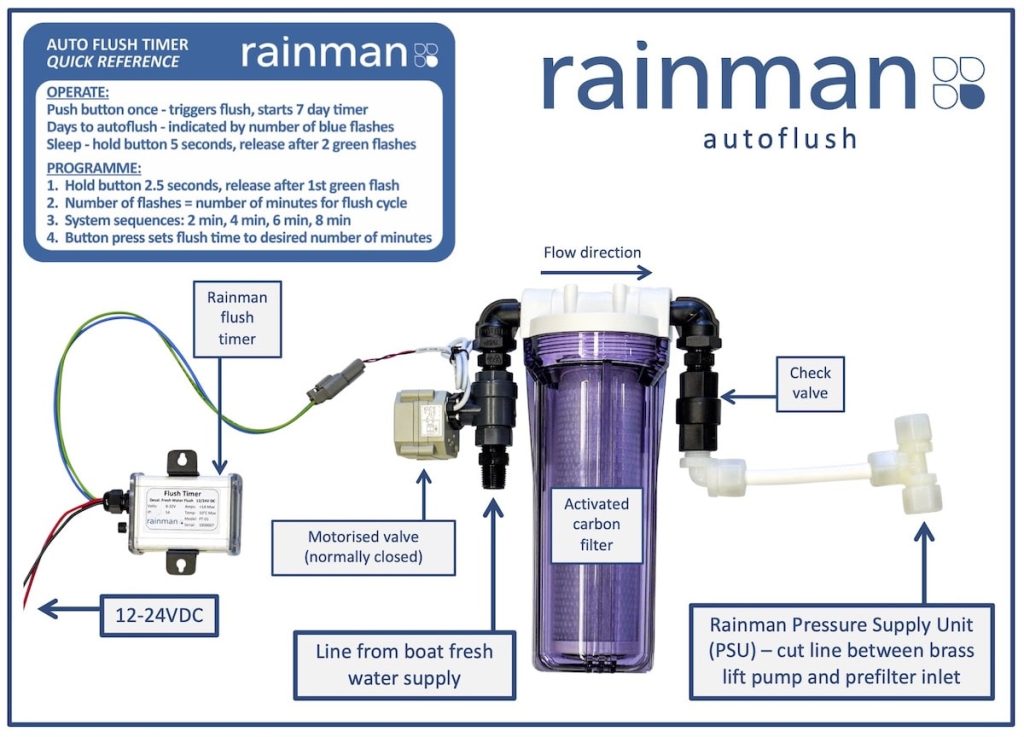
Pickling a watermaker
If you don’t plan on using your watermaker for a while it needs to be “pickled” with a special biocide to prevent growth and buildup which could render your reverse osmosis membrane totally useless.
A watermaker should also be pickled every so often to chemically cleanse the membrane.
In addition to flushing and pickling, you will also need to clean out and replace the raw water pre-filters.
Operating costs
When properly cared for, a membrane should last five to ten years. If you don’t properly flush or pickle your watermaker, it can be a lot sooner and membranes aren’t cheap, generally costing in the range of 200-700 USD.
You’ll also need to purchase pre-filters and pickling solution, which are generally quite affordable. It’s also a good idea to carry spare parts
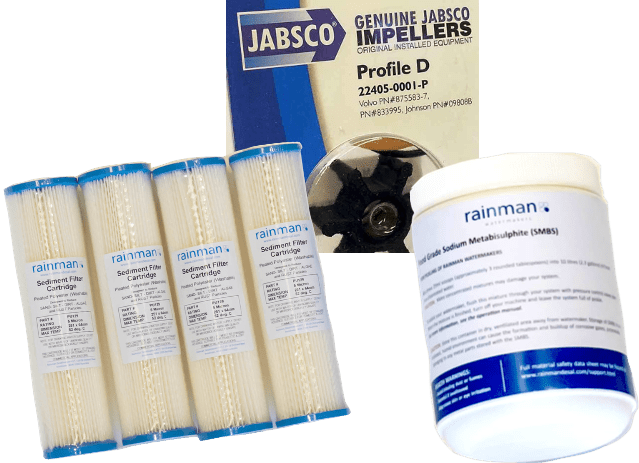
Power consumption
Watermakers can be real power hogs. When Practical Sailor tested a dozen DC watermakers they found they could draw anywhere from 12 to 48 watts per gallon, a huge range in efficiency!
According to Practical Sailor, “for maximum efficiency none of the systems drawing 15 amps or more should be operated without running the engine at the same time.”
We had to run our engine for hours to fill our tanks, which was annoying (and loud) when we were hanging out at anchor and also used up another finite resource—diesel fuel.
In our view, this was the single largest drawback to having a watermaker aboard.
Keep in mind that your power supply will determine what type of watermaker you buy. You may need to upgrade your electrical panels, get a generator or high-powered alternator, add solar panels, or increase battery capacity to supply the demand.
You can’t make water everywhere
While watermakers offer great flexibility and freedom, you can’t just make water in any old spot. If you make water in a polluted marina or anchorage, you’ll risk clogging up your filter. Most cruisers will head out to open water to ensure the saltwater they’re using is as clean as possible.
Key features to look for
Powered or handpump, handpump watermakers.
Handpump watermakers tend to be small and portable, the perfect thing to keep in your ditch bag in the event of an emergency. They’re less expensive than powered watermakers and produce far less water, usually around one gallon per hour.
Though I do know cruisers who have used a handpump watermaker for everyday use, they typically tend to be kept aboard for survival situations.
Powered watermakers
Powered watermakers run off your electrical supply or engine and can produce tens of gallons of water per hour. They tend to be a lot more expensive, but they’re productive enough to replenish your tanks.
Electric or engine drive
Powered watermakers can be electrically driven, by AC or DC, or run off the boat engine.
AC watermakers
AC models can produce in the range of 20-60 gph and are ideal for cruisers with an AC generator or alternator on board. They can also be used on boats with ample solar or wind sources and an inverter.
DC watermakers
DC watermaker systems typically produce in the range of 10-30 gph and are ideal for boats with solar power or 12V battery power.
Engine-driven watermakers
On an engine-driven watermaker, the high-pressure pump is belt-driven. These can produce a considerable amount of water, even on small engines. For instance, engine-driven units produce between 20-60gph, twice what a DC unit can produce.
Energy recovery watermaker
DC watermakers have become more efficient in recent years thanks to energy recovery systems (ERS). When the water leaves the watermaker it is still under pressure. ERS uses a set of valves to make use of this excess pressure to help drive the pump, which can reduce energy consumption by as much as 80 percent.
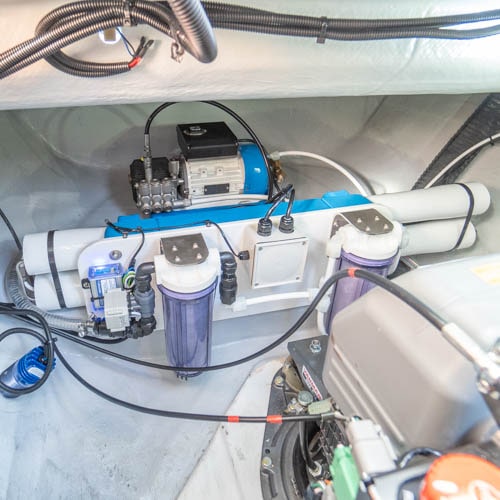
Modular, self-contained, and portable watermakers
Watermakers can be bought as modular, self-contained, and portable units. Choosing the right one may depend on your boat size and layout and whether you’re comfortable installing the watermaker yourself.
Modular units
Modular units come as several separate components that you can mount and connect yourself. This obviously offers a lot more flexibility and is particularly useful on smaller vessels where you may not have a lot of space. The downside is that these systems will take longer to install.
Self-contained units
Self-contained units arrive pre-assembled. While easier to install, they’re often bulkier and best suited to a bigger cruising sailboat with a large engine room.
Portable watermakers
Portable watermaker systems, like the Rainman watermakers, are entirely self-contained. Their compact design makes them easy to move and stow and you can completely avoid a permanent installation.
Simply put the intake and brine discharge hoses overboard, the freshwater hose in your water tank and you’ll be making water in no time.
If you race, have multiple boats, or plan on selling your boat, a portable watermaker is a great option because it can be easily moved from boat to boat.
If we were to buy another watermaker, we would probably opt for a portable one.
Automatic flushing systems
Automatic flushing systems use your boat’s freshwater supply to flush the watermaker for several minutes every few days. These systems require additional components (e.g., a timer, carbon filters, and a motorized valve) and installation but they take a lot of the maintenance out of having a watermaker onboard.
Automatic Pressure Regulation and adjustable pump speed
Your watermaker’s efficiency will be affected by the temperature and salinity of the water you’re cruising in. Cold and highly saline waters (e.g., in the high latitudes) will be more work for your watermaker, so it will take longer to purify.
Some units feature Automatic Pressure Regulation (APR) and adjustable pump speed which can help compensate for fluctuations in water temperature and salinity.
Remote control panels
Some watermakers have the option of a control panel which allows for easier access and remote control. Control panels tend to have a fairly simple interface with just a few gauges but may include a salinity sensor—so you can keep tabs on water quality—and auto-flush integration—so you can flush your watermaker with the flip of a switch.
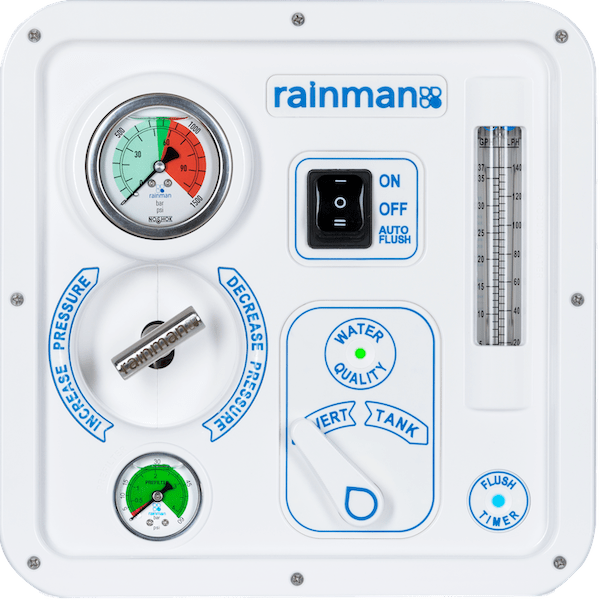
Top watermaker brands
If you’re considering buying a watermaker for a boat, here are some of the top brands to consider.
- Cruise RO Watermaker
- Echotec watermakers
- Horizon Reverse Osmosis (HRO)
- Sea Recovery watermakers
- Schenker watermakers
- Spectra watermakers
Fiona McGlynn is an award-winning boating writer who created Waterborne as a place to learn about living aboard and traveling the world by sailboat. She has written for boating magazines including BoatUS, SAIL, Cruising World, and Good Old Boat. She’s also a contributing editor at Good Old Boat and BoatUS Magazine. In 2017, Fiona and her husband completed a 3-year, 13,000-mile voyage from Vancouver to Mexico to Australia on their 35-foot sailboat.
Terms and Conditions - Privacy Policy
A Guide to Yacht Water Systems
- by yachtman
- September 10, 2023 August 26, 2023

Welcome to the yacht water systems world! Love the open sea? Then understanding and maintaining your yacht’s water systems is key. This guide will provide useful info for smooth sailing. Let’s explore the parts that make up these intricate systems.
The freshwater tank is vital. It holds drinking, cooking, and shower water. Regularly check and sanitize these tanks to avoid contamination.
Watermakers are also needed. They convert seawater into clean, drinkable water. Having an efficient one guarantees fresh water during long trips.
Yachts have plumbing systems too. Pipes, valves, pumps, and filters all play a role in maintaining proper water flow. Regular maintenance and inspection are necessary to detect any leaks or blockages.
Stay informed to make the most of your yachting experience. We will provide expert advice and tips. Don’t miss out on these insights that will guarantee a seamless, enjoyable voyage.
Understanding Yacht Water Systems
To deepen your knowledge about yacht water systems and their functioning, equip yourself with an understanding of the subject. Gain insights into the types of yacht water systems and the significance of proper maintenance.
Types of Yacht Water Systems
Yacht water systems are essential for onboard comfort and convenience. Different types exist, each with its own features and benefits. To explore these, here is a table:
Additionally, hybrid systems incorporate different technologies or alternative energy sources for improved efficiency and sustainability.
The history of yacht water systems dates back centuries, when manual labor was needed to get and transport freshwater on sailing vessels. As technology advanced, innovations made accessing water more convenient and reliable for yacht owners and crew.
Importance of Proper Water System Maintenance
Maintaining a yacht’s water system is essential. Not doing so can cause contamination and breakdowns. Cleaning, scanning for leaks, and switching out filters are crucial to guarantee a reliable supply of water. Also, monitoring water quality and treating it is vital for safety. Search for professional yacht maintenance services for any difficult issues or setup needs.
Apart from regular upkeep tasks, there are other aspects to think about when it comes to yacht water systems. Guaranteeing sufficient storage capacity is vital, as being overly reliant on shore supplies might not be doable in isolated places. Plus, having redundant systems in place can provide a back-up plan in case of emergency or system failure.
Pro Tip: When doing maintenance on a yacht’s water system, always thoroughly read the manufacturer’s instructions and follow them exactly. This will help avoid any unintended damage or problems that could be costly to fix later.
Components of a Yacht Water System
To understand the components of a yacht water system, delve into the details of water tanks, pumps and filters, and plumbing and distribution system. Each of these sub-sections plays a crucial role in ensuring a smooth and reliable water supply on a yacht. Let’s explore the intricacies of each component to gain a comprehensive understanding of yacht water systems.
Water Tanks
Water tanks are essential on a yacht. They store water securely and provide a steady supply. They come in many materials like stainless steel, plastic, and fiberglass . Tanks can be put in below deck, aft compartments, or forward sections . They often have level indicators and filters to monitor water levels and guarantee quality. Invest in quality water tanks for peace of mind and comfort. Get them now!
Pumps and Filters
A yacht water system uses various pumps and filters. Here’s an overview:
- Fresh Water Pump: Provides water pressure throughout the system. Example: Shurflo Aqua King II .
- Saltwater Pump: Supplies seawater for purposes. Example: Jabsco ParMax Plus .
- Bilge Pump: Removes excess water from the bilge area. Example: RuleMate Automatic .
Filters also help remove impurities and contaminants. Types include:
- Sediment Filters: Trap sediment, debris, or solid particles.
- Carbon Filters: Eliminate chlorine, odors, and tastes.
- Reverse Osmosis Filters: Remove dissolved impurities with advanced membrane technology.
- UV Filters: Ultra-violet light disinfects water, killing bacteria, viruses, and microorganisms.
Pro Tip: Regularly maintain pumps and filters. Check manufacturer guidelines for cleaning or replacing filter cartridges, and inspecting pump seals for wear or leakage.
Plumbing and Distribution System
The plumbing and distribution system is key for a yacht’s water system. It lets water move smoothly throughout the vessel. This includes pipes, valves, pumps, and fittings distributing freshwater and removing wastewater.
Let’s look at a table of components:
Modern systems may also have filtration systems and sensors. These filter out impurities and monitor parameters like pressure and temperature.
Plumbing and distribution systems are vital for having clean freshwater on your yacht. Neglecting this system can cause issues like leaks, reduced efficiency, or complete failure. So, yacht owners should inspect, maintain, and upgrade their plumbing system. This ensures convenience, safety, and comfort. Don’t forget to take care of this essential component! Protect your yacht’s water system by paying attention to its plumbing and distribution system.
Maintaining and Troubleshooting Yacht Water Systems
To maintain and troubleshoot your yacht water systems effectively, follow this guide. Clean and sanitize your system regularly to prevent any issues. Learn how to deal with common problems that may arise. And when needed, consider hiring a professional to assist you.
Regular Cleaning and Sanitization
- Make it a habit to clean the water tanks regularly. This helps keep water onboard safe.
- Sanitize the whole water system from time to time to get rid of bacteria, viruses, and other microorganisms. This is a must for hygiene.
- Don’t forget to clean filters and screens. These stop debris from getting stuck in pipes.
- Inspect and scrub faucets, showerheads, and other water outlets to avoid mineral build-up.
- And when you come back from a trip or if the yacht has been still for a while, flush out the water lines. Stagnant water can cause bacteria.
Remember, cleaning and sanitization is not only good for health, but also for preserving your yacht’s water systems.
Dealing with Common Issues
Boating owners know the annoyance of common water system issues on yachts. It’s vital to take swift action to prevent sailing difficulties. Here are some common problems and how to manage them:
- Leaks: Inspect and fix any pipe or fitting leaks ASAP.
- Clogged Filters: Clean or replace filters for efficient system performance.
- Pump Malfunction: Check the pump regularly to maintain water pressure.
- Foul Odors: Clean and disinfect tanks and pipes to reduce bad smells.
It’s also smart to have spare parts and a dependable technician handy. Taking care of water systems is key to avoiding headaches.
Furthermore, preventive maintenance is essential. Flush tanks, check valves, and scan hoses regularly to diagnose potential issues early.
A cautionary tale shows the importance of dealing with common issues. A group of sailors set off on a voyage and found their freshwater supply was severely reduced due to leaks. With no easy way to fix the issue, they had to ration water severely. This story serves as a reminder of the need to address common issues to avoid troubles at sea.
Hiring Professional Help
- Go for a reliable firm or expert with a good track record in taking care of yacht water systems.
- Check out their qualifications like licenses and certificates to make sure they are fit for the job.
- Get references from previous customers to judge their dependability and quality.
- Chat about your personal needs to be certain they know what to do.
- Find out the total cost, including any extra payments.
- Stay in touch throughout the process to rapidly address any dilemmas.
- Also, enquire if they provide warranties or guarantees for their services. And make absolutely sure you understand their maintenance plan to avert any unexpected surprises later.
Tip: Inspect your yacht’s water systems often and do minor upkeep yourself to prevent bigger difficulties.
Tips for Efficient Water Usage on a Yacht
Efficient water use is paramount in a yacht environment. Limited resources and an isolated lifestyle mean making the most of your supply is vital. Here are tips to help you stay efficient and minimize wastage on your voyage:
- Try installing water-saving fixtures like low-flow faucets and showerheads. These can reduce water use without diminishing comfort.
- Be aware of your daily habits. Simple things like turning off the faucet while brushing teeth or using a dishwasher with a full load can make a real difference.
- Consider implementing a greywater recycling system. This allows you to reuse water from sinks, showers, and laundry for non-drinkable activities like flushing toilets or cleaning decks.
It’s also important to take good care of your yacht’s water systems. Check for leaks, repair any issues straight away, and clean filters often for the best results.
For an unforgettable yachting experience and a greener future, follow these tips for efficient water usage on your voyage. Every single drop counts!
Wrap up of yacht water system guide? Check! Reliability and efficiency is a must for a blissful sailing experience. Maintenance and monitoring are key.
We’ve looked into different systems available, their components, and factors to consider when choosing. Water quality and methods to make sure it’s top-notch also discussed.
Water scarcity not yet covered . Climate change and sustainability are becoming more pressing. Yacht owners must be conscious of usage and adopt conservation practices.
Take advantage of reliable water systems. Invest in regular maintenance and check out new technologies. Now is the time to make sure you can sail worry-free and protect our water resources.
Frequently Asked Questions
FAQ 1: What is a yacht water system?
A: A yacht water system refers to the plumbing and supply system that provides fresh water on a yacht. It includes tanks, pumps, filters, pipes, faucets, and showers.
FAQ 2: How do I fill the water tanks on my yacht?
A: To fill the water tanks, you can connect a shore hose to the dockside water supply or use an onboard watermaker or desalination system to convert seawater into fresh water.
FAQ 3: How often should I sanitize the water tanks?
A: It is recommended to sanitize the water tanks at least once a year. You can do this by using a water tank cleaning solution and following the manufacturer’s instructions.
FAQ 4: How do I prevent water contamination in my yacht’s water system?
A: To prevent water contamination, always ensure the water tanks are clean and properly sealed. Use potable water hoses for filling, regularly replace filters, and avoid using the water system for anything other than drinking and cooking.
FAQ 5: What should I do if there is no water flow from the faucets?
A: If there is no water flow from the faucets, check if the water pump is turned on and if there is a sufficient water supply. Also, inspect the filters and valves to ensure they are not clogged or closed.
FAQ 6: How do I winterize the yacht water system?
A: To winterize the yacht water system, drain all water from the tanks, pumps, and pipes. Use antifreeze to protect the system from freezing, following the manufacturer’s instructions. It is best to seek professional assistance for winterization.
Leave a Reply Cancel reply
Your email address will not be published. Required fields are marked *
Save my name, email, and website in this browser for the next time I comment.
An introduction to watermakers for yachts

With thanks to VDM - Reya , Astilleros de Mallorca and Sea Recovery
While water management systems are vital to the smooth and cost-effective running of superyachts, they must operate seamlessly, effectively and without hassle. With a huge demand for fresh water for showers, baths, food preparation, laundry, washing down, etc. superyachts need to be able to produce their own fresh water through desalination.
Find suppliers of yacht watermakers in your area here

Having a yacht watermaker (also known as reverse osmosis desalination systems) on board is a huge advantage because of the reduced need to have large, heavy water tanks on board for long charters. Depending on the design, superyacht watermakers can be powered by electricity from the battery bank, an engine, or an AC generator.
The importance of a yacht watermaker
Astilleros de Mallorca commented, "First and foremost safety should be a paramount concern. When you consider the average superyacht passenger can consume anywhere from 30 gallons of water to 100 gallons of water per day, having a fully functional and quality watermaker on board, greatly limits the potential risk to crew and passengers by providing virtually limitless fresh water. This becomes even more essential in the event of an emergency that keeps a superyacht offshore for an extended period of time. This provides both crew and passengers with peace of mind."
Having the ability to make fresh water while you are underway frees the superyacht from the burden of carrying the water weight necessary to accommodate an entire voyage. Consider this, water weighs approximately 10 pounds per UK gallon (8.3 per US gallon) this extra weight adds up and can reduce the distance you can travel over a given period of time. It is also worth considering that if the superyacht is power driven, fuel costs will increase according to the additional weight carried on the journey.
How much water do you need?
There are plenty of watermakers on the market, but what sort of capacity is best for you? Experts say around 25 to 50 gallons of water per person per day is enough, you’re not going to drink that much water, certainly, or use nearly that much for showers and cooking, but an awful lot of water is used to wash down boats.
Of course, whatever the watermaker is used for, you’ve still got to figure out how often, and how long, you want to operate it. If you use, 30 gallons per day and you want to desalinate for three hours every day, you’ll need a 10 gallon-per-hour watermaker, or 240 gallons per day, to keep the tanks topped up. But a 400-gallons-per-day model, making 16 gallons per hour, will let you desalinate every other day for just less than four hours. It’s a balancing act.
Yacht watermaker misconceptions
When considering a watermaker for a smaller vessel, a complete picture is needed. There are some common myths which need to be dispelled before a fair decision on purchasing one can be made.
Myth 1: Watermakers are an expensive piece of equipment
It's true that a yacht watermaker may not be an essential piece of kit on a smaller vessel, but it is still an investment that must be thought about. (A very basic water model today costs somewhere upwards of £1500 for a yacht up to 20m and yachts over 30m start at around £14,000)
The cost of a watermaker is just as relative as GPS, radar, fenders, interior design, etc…, and just like this other equipment it offers convenience, flexibility and peace of mind.

Myth 2: Maintaining a watermaker is difficult and costly
A watermaker needs little maintenance and is much less of a drain on time and money then first considered.
watermaker membranes are probably the most expensive part to purchase, but just like everything else if looked after from the beginning and routinely flushed and then pickled, so the need to replace the membrane will become less frequent. Prevention is the key with watermakers, if you maintain them properly, they require little investment.
See a guide on watermaker maintenance here
Myth 3: Pickling a watermaker is complicated
Pickling is the process of preparing a watermaker for storage if it will not be used for a period of time. There seems to be an overwhelming misconception in the boating industry that this is a complicated process.
Firstly, it is not. Simply put, pickling is storing a watermaker. The only difference is that flushing the system with a solution is needed to prevent the growth of bacteria. That's it.
When the watermaker is needed again, just discard the product water for the first 15 - 20 minutes to be sure the solution has been completely rinsed from the system.
Myth 4: A lot of power is needed
As mentioned previously powering a watermaker can be done using a variety of methods (electricity from the battery bank, an engine, or an AC generator.) Most watermakers are engine-driven, in which case battery power isn’t getting used. If a motor boat is owned, the engine will be used all the time. If a sailboat is owned, the engine will be used regularly to accommodate for no wind. If the engine is going to be run anyway, why not use the energy to fill water tanks?
Battery-powered watermakers do consume a lot of power and sacrifices may have to be made when deciding on what to use fresh water for. However, Fabienne Guerin from Reya SAS , experts in electricity production and conversion commented, "Batteries have developed over the years allowing new opportunities for superyachts, commercial boats and offshore vessels.
Having exposed these myths around yacht watermakers, hopefully a fully informed decision can be made on whether or not one would suit your boat or superyacht.

Tried & Tested

A jacket completes any crew member's uniform so it's an important garment to get right. In this Tried & Tested, Sea Design pits eight popular jackets against one another to determine which one is best for superyacht crew in 2023.
iAQUA creates high-performance, technologically advanced underwater scooters. In this Tried & Tested, a team of experienced testers have rated and reviewed the AquaDart Pro and AquaDart Nano series to reveal the stand-out iAQUA sea scooter.
In our 2022 Tried & Tested, yacht toy specialist EAMS and a group of captains and crew review a selection of the very best luxury water toys on the market. Find out which toy was crowned the winner...
EXTRA Yachts, a brand of Palumbo Superyachts, has announced the US premiere of the new EXTRA X99 Fast at the 2024 editio...

European-founded crew uniform specialists Coco & Kandy Crew has unveiled an updated brand image, revamped website, and a...

Popular Articles
Finished reading now find your perfect supplier..
Search our industry-leading directory for over 20,000 superyacht suppliers, providers and marinas.
- Motorcycles
- Car of the Month
- Destinations
- Men’s Fashion
- Watch Collector
- Art & Collectibles
- Vacation Homes
- Celebrity Homes
- New Construction
- Home Design
- Electronics
- Fine Dining
- Baja Bay Club
- Costa Palmas
- Fairmont Doha
- Four Seasons
- Four Seasons Private Residences Dominican Republic at Tropicalia
- Jacob Cohën
- Reynolds Lake Oconee
- Wilson Audio
- 672 Wine Club
- Sports & Leisure
- Health & Wellness
- Best of the Best
- The Ultimate Gift Guide
Meet the New Class of Freshwater Superyachts Bringing Bold Design to the Lakes
The vessels resemble their oceangoing cousins, but with expanded design possibilities., michael verdon, michael verdon's most recent stories.
- How a Little-Known Dublin Book Fest Transformed Into an A-Lister Summer Favorite
- The World’s Most Expensive Meal Will Cost You $495,000—and It Will Be Served in a Space Balloon
- This Sleek New Zero-Emissions Jet Will Fly on Liquid Hydrogen
- Share This Article

The term “freshwater yacht” was an oxymoron until J. David Weiss designed Invictus , a futuristic 80-footer that redefines large houseboats. Having penned dozens of oceangoing superyachts for Europe’s leading builders, Weiss was given carte blanche by Arizona-based Bravada Yachts to create a new freshwater category. “The designs have typically been boxy, bloated RVs,” he says. “The good news is their scale can provide a custom yacht experience.”
Related Stories
- The Mercedes G-Wagen Is the Least Eco-Friendly Car on the Market, a New Study Says
- The Newest Nissan GT-R Could Also Be the Last
- ‘People Don’t Want to Be Inside’: How the Outdoors Became Yachtmakers’ Most Coveted Design Element
The nearly $2 million Invictus has 3,200 square feet of space across two decks. The sprawling interior, with nine-foot ceilings, includes five staterooms, two full kitchens, customized daybeds and, true to its lake-boat DNA, a 15-foot water slide, while omnipresent glass delivers exceptional water views. Since even big lakes experience minimal wave action—at least compared to ocean swells—Weiss was able to push certain aspects of the design. “Bringing glass so low to the waterline is unheard of on a superyacht ,” he says. “Those kinds of differences let us explore what was possible” within the new category.

The 80-foot Invictus promises to be the first of a new generation of freshwater superyachts. Bravada Yachts
Companies in Australia and Germany are also launching new glass-centric freshwater designs. Status’s 60-foot, tri-deck Mischief , while boxier and less maneuverable than Invictus , has a sprawling, upscale interior, while a 90-foot, single-deck model from Berlin-based HouseBoatYacht resembles a floating glass studio.

The 60-foot, tri-deck Mischief . Status
Weiss expects a rapid evolution in the segment, with ever-larger and more elaborate designs. “It’s a great opportunity to move beyond the best-in-class designation and instead design a whole new class,” he says. “We’re really trying to do justice to what these vessels should look like in the 21st century.”
Bravada is entertaining a proposal for a 120-footer complete with helipad. “We’re also designing one for a music label with a recording studio on board,” he says. “The owner wanted unusual features and colors, and we’ll be delivering that.”
Read More On:
More marine.

This New 220-Foot Custom Superyacht Is Topped With an Epic Jacuzzi


This Custom 112-Foot Trideck Superyacht Feels Bigger Than It Actually Is

Azimut’s New 72-Foot Yacht Has One of the Largest Flybridges in Its Class. We Hopped Onboard.

You Can Charter Lürssen’s New 400-Foot Gigayacht for $3.3 Million a Week

Culinary Masters 2024
MAY 17 - 19 Join us for extraordinary meals from the nation’s brightest culinary minds.
Give the Gift of Luxury
Latest Galleries in Marine

‘Lady A’ Superyacht in Photos

8 Fascinating Facts About ‘Kokomo,’ the Lightning-Fast 192-Foot Sailing Superyacht
More from our brands, exclusive: kourtney kardashian barker talks lemme’s recent target launch ahead of celebratory star-studded brunch, angel city for sale: nwsl’s most valuable team seeks new owner, country singer jimmie allen settles with accuser in sexual assault lawsuit, andy warhol museum director patrick moore to resign amid scrutiny over pop district project, the best yoga mats for any practice, according to instructors.
Yacht Watermakers
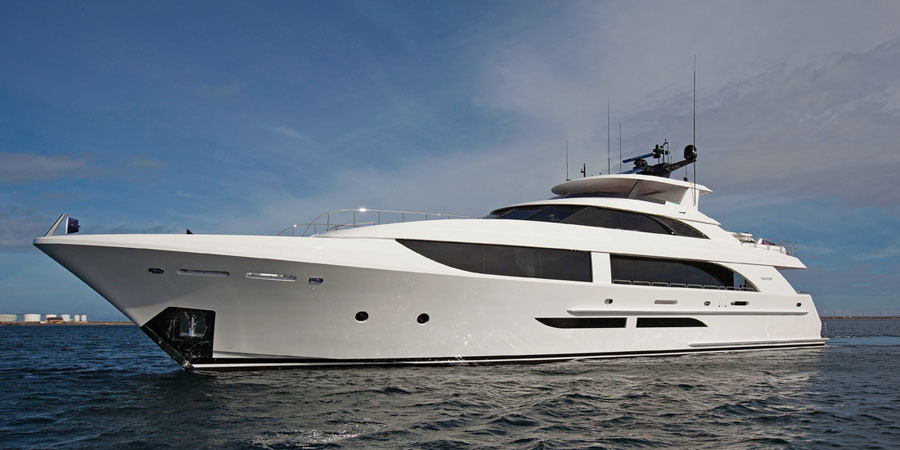
December 15
How Do Yachts Get Fresh Water: Do Superyachts Have Desalination?
YACHT UNIVERSITY BLOG
0 comments
Do Superyachts Have Desalination?
For those who love luxury and the open sea, owning a superyacht is the ultimate dream. These floating palaces come with alla the bells and whistles of a five-star hotel, including the ability to generate fresh water through desalination. But do all superyachts have this capability? Let’s find out.
What is Desalination?
Desalination is the process of removing salt and other minerals from seawater to produce fresh drinking water. This is done through various methods such as reverse osmosis, distillation, and electrodialysis. Desalination has become increasingly popular in recent years, particularly in areas where fresh water is scarce.
Most modern superyachts are equipped with desalination systems. These systems are essential for long voyages, particularly those that take place in remote areas where fresh water is scarce. A typical superyacht desalination system can produce anywhere from 1,500 to 35,000 liters of fresh water per day, depending on the size of the yacht and the system’s capacity.
Desalination systems are also becoming more advanced and efficient. Many superyachts now use energy recovery devices that harness the pressure from the saltwater to power the system, reducing the need for external energy sources.
Why Do Superyachts Need Desalination?
Superyachts are essentially self-contained floating cities. They have everything from gourmet restaurants and swimming pools to movie theaters and spas. All of these amenities require water, and fresh water can be hard to come by in the middle of the ocean.
Having a desalination system on board means that superyachts can generate their own fresh water supply, allowing them to stay at sea for longer periods without needing to dock and refill their water tanks. This is particularly important for those who enjoy exploring remote areas or taking part in extended ocean crossings.
Desalination, Yacht Crew, Yachts, Yachts desalination
You may also like
Caribbean cruise adventure, mediterranean cruise, get in touch.
Session expired
Please log in again. The login page will open in a new tab. After logging in you can close it and return to this page.
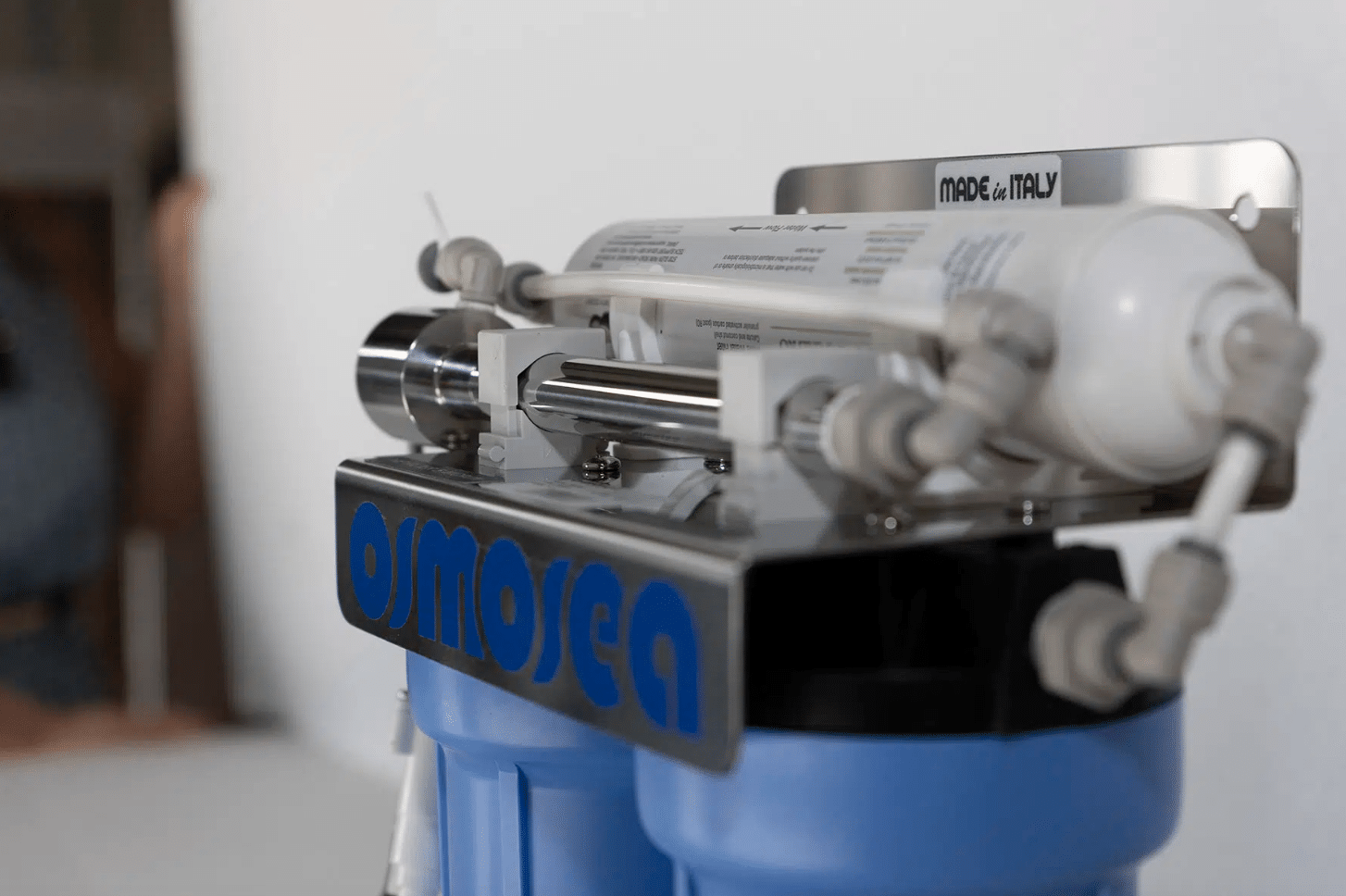
Osmosea watermakers: the privilege of getting fresh water aboard at all times

Osmosea watermakers: the freedom of having fresh water on board at all times
One of the things that you need to keep most under control when on board is unquestionably the amount of fresh water available. Osmosea knows this well. The Sicilian watermaker and water treatment plant company, in fact, successfully promotes installations all over the world to make you independent from the water supply in port, and more.
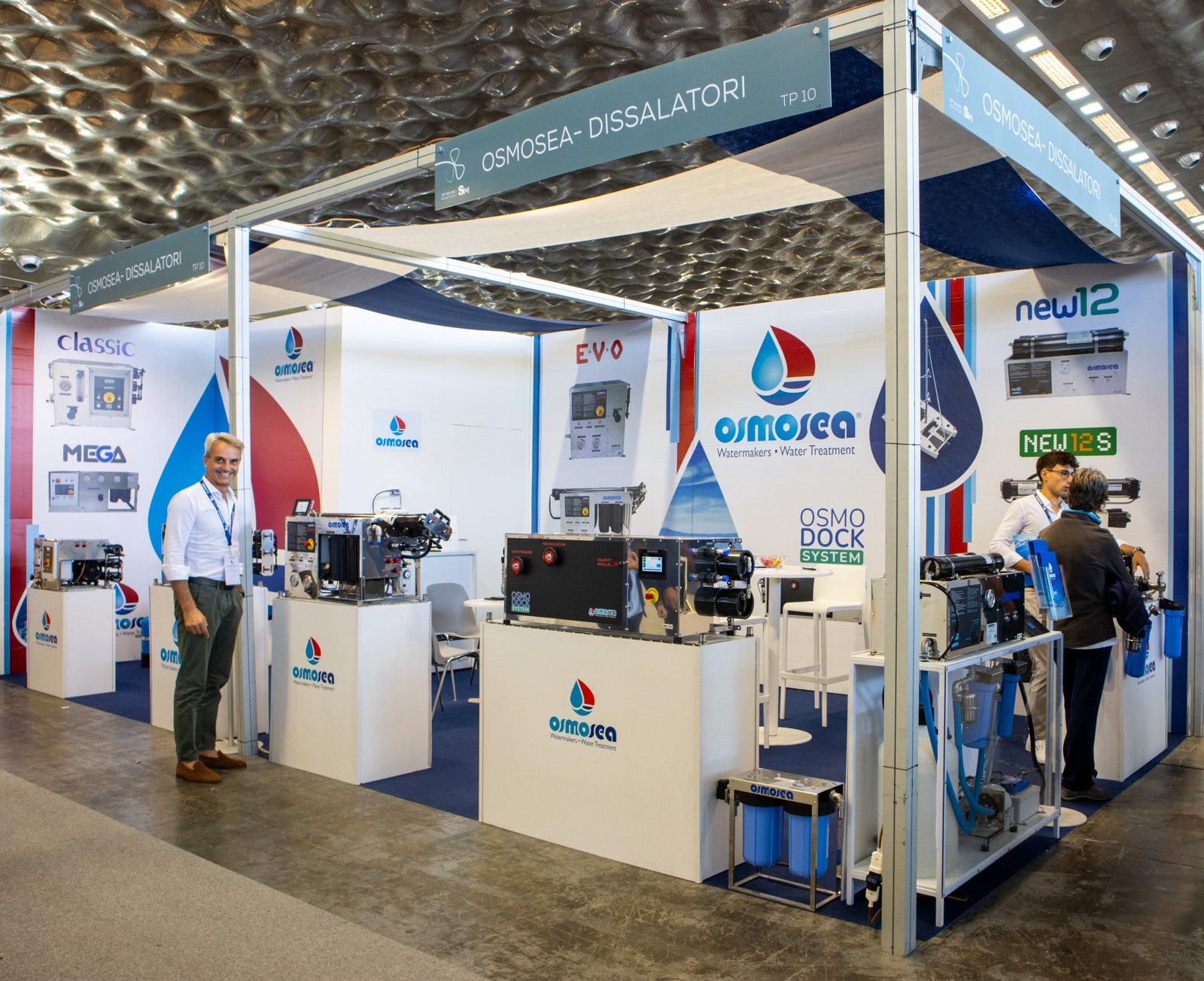
With NEW 12 and NEW 12S , the energy-saving watermakers save about 80% of power and are suitable for small to medium-sized boats. The range also includes the Classic and Evo models, watermakers powered by a generator, with flow rates of up to 3,000 l/h.
It is also possible to install the DUO , i.e., a system composed of 2 watermakers (which occupies little more space than a single watermaker) and allows to choose a different type of power supply (12/24V or 230V), and provides the security of having a backup system even in case of failure, and finally, also allowing to adjust a different amount of production between the two watermakers, adapting it to various needs.

The Sicilian company’s products are already highly appreciated (and installed) around the globe, which is why Osmosea is aiming to participate in the most important international boat shows, making its first debut at the Fort Lauderdale International Boat Show, and then attending METS next November, as well as Boot in Düsseldorf in January 2024, starting the show season again in the spring of 2024.

Osmosea srl
C.da Amabilina 756 Z.A 91025 Marsala (TP)
Tel. +39 0923 719867 E-mail: [email protected]
You might be interested in.
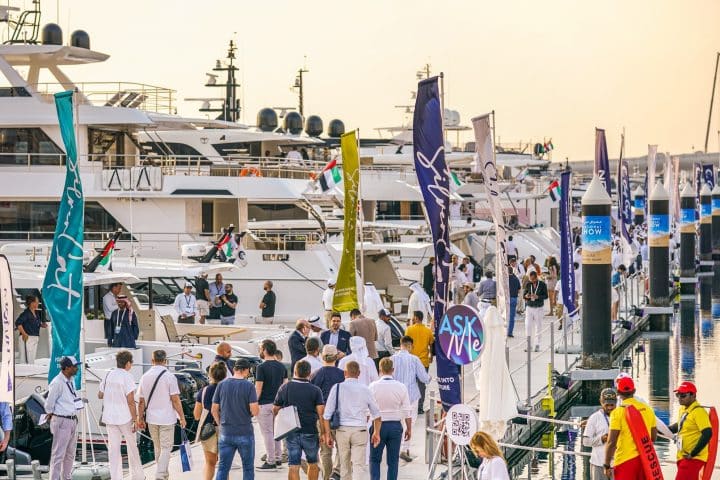
Dubai International Boat Show, 30th edition kicks off
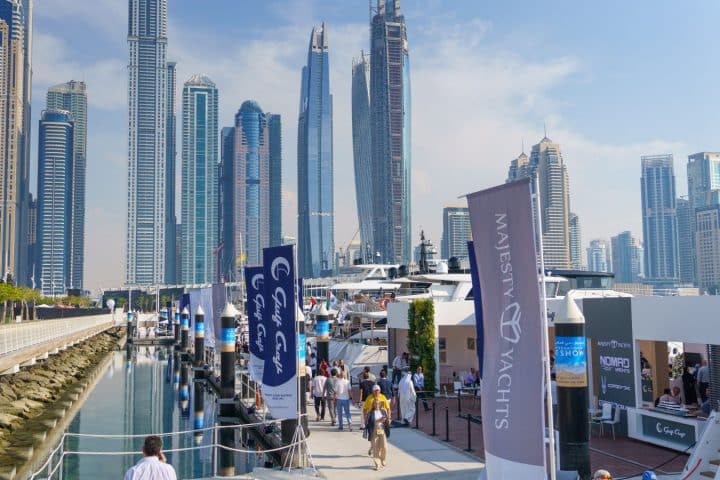
Dubai International Boat Show and The International Yachting Media: media partnership agreement signed for second year

Guidi Srl: special focus on materials in marine accessories

CMC Home & Yacht Upholstery: where passion meets Made in Italy
Subscribe for latest updates.
Sign up to receive the best of superyachts news, world premieres and shipyards new models.
The only ADVERTISING FREE newsletter
Yachting World
- Digital Edition

Water for sailing: We survey the ARC fleet to find popular options
- Toby Hodges
- June 24, 2021
How to stow, conserve or generate drinking water for sailing is key for any offshore sailor. Toby Hodges surveyed the 81 skippers of the ARC 2020 fleet for tips

Water is the source of all life. For any sailor considering extended cruising or an ocean crossing , the ability to carry or produce sufficient fresh water for sailing is a top priority.
But how do you decide how much water to ship or how best to generate your own? Our survey of the Atlantic Rally for Cruisers (ARC) fleet last year focused on water.
We asked the skippers how much water they carried for sailing, in what form, how it was used and, for the majority with watermakers, detailed questions about the generation of water and how the equipment performed at sea.
Since we last ran a survey on this topic in 2014 our collective attitude towards waste has arguably changed for the better. That fleet of 193 yachts carried over 28 tonnes of bottled water with them across to the Caribbean. All sailors today should consider how every consumable item they carry aboard will be disposed of when they reach their destination.

Pogo 12.50 Rush. Photo: James Mitchell
The main decision ocean sailors face with water stowage is whether to fit a watermaker, which is both a practical and a financial decision. Generating your own water is one of the best investments cruising sailors can make towards comfort and true independence.
ARC skippers over the past two decades have consistently described watermakers as one of their most vital pieces of equipment. “To us, a watermaker is the single best thing you can have for cruising by a fair margin and fully changes the game,” thinks Rush ’s Ian Baylis.
Three-quarters of the skippers who replied to our survey had watermakers aboard. The seven yachts listed as not carrying one were all smaller entries between 35ft and 45ft and typically over 20-year-old models. They carried extra water in bottles and jerrycans and used it sparingly.
Usage and conservation of water for sailing
Being frugal with water becomes second nature to most cruisers. The majority of respondents said their crew only showered every three days, 12 every two days and 13 daily.
One of the most common pieces of advice from skippers concerning water conservation is to fit a saltwater tap and to use seawater whenever you can. “Cook with salt water when possible,” advises the crew of Montana , a Swan 48 S&S from 1973. Yet over half of the respondents did not have a saltwater tap fitted in their galley, nor even a manual freshwater pump in the galley or the heads.

“The saltwater tap in the galley is essential,” thinks Tobias Gröpper on his Sunbeam 44 Pivot . “We still have 50% of our tank capacity on arrival although we took showers etc.”
Jorn Aalefjær, the Norwegian skipper of Ticora III , and Dane Martin Nielsen aboard his Jeanneau 53 also both stressed the benefit of fitting a saltwater tap.
Suffisant , one of the smallest entrants, a Beneteau Oceanis Clipper 331 from 1990, has only small tanks, but uses a Katadyn Power Survivor 40E watermaker. They used salt water to wash with and had manual taps fitted in the galley and heads.
Swiss skipper Marina Passet says: “Salt water is no use for washing clothes, but can be used for brushing teeth, washing dishes and vegetables.”
Article continues below…

Water on board: what should you carry? We ask ARC skippers for tips for an Atlantic crossing
Water is fundamental to every sailor’s survival at sea and one of our first priorities. To spend extended periods afloat,…

Catamaran sailing across the Atlantic: Why multihulls are taking over the ARC
Something big has happened in ocean sailing. It could be the tipping point in the 34-year history of the Atlantic…
Seasoned cruising sailors the Blacks aboard Bowman 57 Emily Morgan , say they have used their set-up for 8,500 miles and would not do anything differently. They relied on their Spectra Ventura watermaker, but advise closely monitoring the tanks: “We graph tank levels daily,” says Anna Black. “If the level is below the line then no more fresh water showers until it returns. Allow 20% extra in case of problems.”
Many other crews, including on the Sunbeam 42.1 Ibex , were happy relying on desalinated water without needing large back-up quotas of water.
The Chung family aboard Kaizen use a four-filter system to purify their water and drink everything from the tank. They have an instant hotwater tap, and “we make our own sparkling water and have reuse cannisters for emergency”, says Kean Chung. Their Oyster 49 has 1,000lt tanks and a Sea Fresh H20 watermaker, so the crew were able to shower daily and there was no need for any bottled water.
Water stowage
There should be no need to rely on single-use plastic water bottles when cruising. Reusable bottles, flexible or collapsible bladders and jerrycans are a perfectly adequate solution for storing reserve water, particularly if you have a good filtration system.

Use salt water when possible, for washing clothes, dishes or taking showers. Photo: Thomas Horgen
Recycling plastic is not possible on many islands. While in recent years IGY Rodney Bay Marina has provided a plastic recycling service for visiting yachts, run in co-operation with a local community group, due to COVID restrictions the service was suspended in 2020.
So it was disheartening to find that nearly half the fleet still shipped over 100lt of bottled water each, while seven yachts carried over 250lt of bottled water, despite five of these having a watermaker.
Many skippers still like to carry bottled water as a contamination-proof back-up or for monitoring intake. Aboard Escapado for example, a Beneteau first 40.7 with no watermaker, they carried over 250lt of bottled water.
Skipper Sophie Iona O’Neill says: “One person kept a tally and did three fills of everyone’s water each day.” She says the total daily consumption amounted to: “two litres of drinking water per person, plus one litre of tea/coffee, giving a total of 3lt of fluid per person, per day,” – a useful statistic for those planning water consumption.
Water generation
If installed correctly and serviced properly, a watermaker should perform consistently well. The majority of 2020 ARC skippers rated their watermakers most highly, with 70% giving 5/5 for reliability.

Wash-up in seawater, then just rinse in fresh. Photo: Tor Johnson
Just eight skippers reported having any issues with their equipment. Any problems were either fixed with spares or the result of another issue, such as a power source problem ( Adagio had issues with their genset and, in the case of the Malo 43 Ydalir II , the fault was traced to a leak onto the inverter).
The few who experienced any faults with their watermaker’s performance were typically those who had only installed it that season. The overriding advice is to make sure you have tested your system thoroughly at sea before embarking on an ocean passage.
With prices typically ranging from £4,000 to five figures, it is worthwhile making sure a watermaker is working smoothly and knowing how to service it properly in advance.
Have the power
The ability to harness power naturally and to store it efficiently is changing the watermaker world. “If you don’t want to use diesel to make water you need a lot of power generation,” warns Lucky Girl ’s Charlie Pank, who has a Schenker Modular 30. However, only five skippers say they increased their battery capacity when their watermaker was fitted.
Paul Lemmens was very happy with his Rainman AC 120lt per hour unit aboard his Hanse 455 Veni Vidi Vix , but advises: “You need good batteries/large inverter to function.” He fitted an extra 400Ah of lithium batteries when the watermaker was installed.
The advent of high DC power has had a marked effect on watermakers, says Mactra Marine’s Jim MacDonald, who, COVID restrictions apart, usually attends the ARC start for any last-minute watermaker problems or services. “Go for a low-energy system that will run off the batteries,” he advises. A good bank of solar panels or a hydrogenerator can really help – nearly half the fleet used solar to help charge their batteries.

Many of the crews in the ARC still carry significant amounts of bottled water.
“As lithium has become more prevalent, DC systems with energy recovery are coming into their own,” MacDonald continues. “This means that whatever your means of power generation, you can always use your watermaker – whereas with the old-fashioned AC/high-pressure pumps you had to run the genset to make it work.” He has also seen the reliability of modern watermakers improving as they increasingly use electronics where possible.
Despite its modest output of 20lt per hour, the Blacks on Emily Morgan rate their Spectra Ventura very highly. They installed it themselves in 2017 and describe it as “invaluable in the Pacific – simple and reliable”.
The German Schaals aboard their Bavaria Cruiser 42 Nikajuma say they wouldn’t change their set-up and that the Echo Tec DML260 always worked – but noting “that the test tap is very important”.
Filtering water
Whether storing water in tanks or making desalinated water from the sea, filtering out any impurities makes sense. “We added 5ml of chlorine in the tank to kill bacteria and used LaVie water purifiers to get the chlorine smell out of the tap water we drank,” says Patrice Charbon, who was sailing the new Fountaine Pajot Astrea 42 Eden Blue for LP4Y with four friends.

Bottled water is still popular on board, despite the potential environmental impact. Photo: James Mitchell
They were trialling a new form of UVA water filtration technology on their desalinated water. Charbon, an associate of the inventors Solable, explains: “The strong LED light beam generates UVAs which break the chlorine molecules. As a side effect, an advanced oxidation process flushes the water eliminating all molecules of pesticides, medicine or hormones that one can find in tap water.
“A 30-minute purification would bring fresh, pure water to our table every day,” concludes Charbon, calculating that the watermaker and filters helped them save “over 200 plastic water bottles for our crossing and over 12kg of PET since our departure”.
If you enjoyed this….
Yachting World is the world’s leading magazine for bluewater cruisers and offshore sailors. Every month we have inspirational adventures and practical features to help you realise your sailing dreams. Build your knowledge with a subscription delivered to your door. See our latest offers and save at least 30% off the cover price.
RO Reverse Osmosis & Water Treatment | Commercial & Industrial

RO / MEMBRANE SYSTEMS

WATER FILTERS & SOFTENERS

CONTAINERIZED SYSTEMS

CIP SYSTEMS & UV STERILIZERS
- Water Refill Station Cost Calculator
- Water Treatment in South America
All You Need to Know About New Fresh Water Maker from Sea Water
A fresh water maker from sea water is a system or machine to desalinate of seawater through reverse osmosis membrane technology (SWRO). So, Chunke fresh water makers from sea water systems provide clean, safe and tasty water.

Our small size reverse osmosis desalination equipment helps to minimize the disadvantage of water scarcity by allowing decentralized water supply. So, Chunke fresh water maker from sea water machines are skid mounted, plug and play and easy to operate. Chunke SWRO plant production capacity can vary from 100 to 1000 liters per hour. If you need bigger capacity than this range, you can check our commercial sea water desalination systems and industrial sea water desalination plants accordingly.
Is there a machine that turns saltwater into freshwater?
Yes, fresh water maker from sea water machine is using reverse osmosis membrane filtration technology to turn sea water into drinking water.
How do you turn sea water into fresh water?
There are two method to turn sea water into fresh water.
1. Distillation and Condensation

We remember from science class, if we boil water, it makes vapor and if this vapor face with cold surface it turns liquid water. So, in this process, water rids of most of solid contaminants and salts. Distillation desalination is one of mankind’s earliest forms of water treatment, so it is still a popular treatment solution throughout the world today. In ancient times, many civilizations used this process on their ships to convert sea water into drinking water. So, today, desalination plants are used to convert sea water to drinking water on ships and in many arid regions of the world, and to treat water in other areas that is fouled by natural and unnatural contaminants. Hence, distillation is perhaps the one water treatment technology that most completely reduces the widest range of drinking water contaminants. But in this process, you need plenty of energy to heat up water and condensate.
2. Reverse Osmosis Desalination

Reverse Osmosis (RO) is a membrane-based demineralization and desalination technique used to separate dissolved solids (i.e., ions) from solution (most applications involve water-based solutions, which is the focus of this work). So, membranes in general act as perm-selective barriers, barriers that allow some species (such as water) to selectively permeate through them while selectively retaining other dissolved species (such as ions). RO perm-selectivity compares to many other membrane-based and conventional filtration techniques. As shown in the figure, RO offers the finest filtration currently available, rejecting most dissolved solids as well as suspended solids. (Note that although RO membranes will remove suspended solids, these solids, if present in RO feed water, will collect on the membrane surface and foul the membrane. So, please watch our video from link, “How to turn sea water into fresh water, drinking water”.
Is it easy to operate and install fresh water maker from sea water?
Yes, it is very easy. Because fresh water maker from sea water machine is skid mounted system. You just need to connect, main electrical cable, inlet water pipe, fresh water output pipe and waste water pipe.
You can watch video and you can easily to understan how to install and operate fresh water maker from seawater from below video.
Can you drink water from a boat watermaker?
With a boat watermaker or fresh water maker, all it takes is one flip of a switch to fill up your tanks with safe-to-drink water. Chunke is your leading choice to find the ideal watermaker for your boat. For 20 years, we have provided the marine industry with the purest, highest quality drinking water.
How much does it cost to convert saltwater to freshwater?
In ft that it depends on capacity of fresh water maker from sea water machine. As regards to capacity, we are using high pressure pump. Bigger capacity needs bigger seawater high pressure pump. For 100 liters per hour fresh water maker electrical consumption is 2.5kW/hour. And all system cost is dependent on which brand and material you want to use in machine.
To get your free quote, please click the below botton.
Is it OK to drink desalinated water?
Yes, it is safety and clean. So, desalinated water, provided that it’s clean, is perfectly fine to drink, and a lot of it is already being consumed both in the United States and abroad. Meanwhile, you can watch our detailed video about “ is it healthy to drink reverse osmosis treated water. “
How do big or mega yachts get fresh water?
Big size or superyachts need to be able to produce their own fresh water through desalination. Hence, having a yacht watermaker (also known as reverse osmosis desalination systems) on board is a huge advantage because of the reduced need to have large, heavy water tanks on board for long charters.

How much does it cost to desalinate 1 gallon of water with fresh water maker from sea water?
Technology is imporing in reverse osmosis technology, so, it has brought desalination costs closer to other alternatives. Meanwhile, ten years ago, desalinated water cost more than $9 per 1000 gallons, but today, the range is $2 to $5 per 1000 gallons.
Does desalinated water taste good?
Desalinated water taste is same with most of bottled water. As you know that reverse osmosis systems remove most of minerals. If you want to get mineral water, we can add mineralization filter or mineral dosing to your treated water after RO Plant .
Which membrane brand do I use in fresh water maker from sea water?
You should use sea water reverse osmosis membrane, mostly we are prefering to use below mentioned brands.
- Dupont Filmtec SWRO Membrane
- Toray SWRO Membrane
- Vontron SWRO Membrane
- Hydranautics SWRO Membrane
To get more info about fresh water maker from sea water, please fill in the form...

- Entertainment
- Rex Reed Reviews
- Awards Shows
- Climate Change
- Restaurants
- Gift Guides
- Business of Art
- Nightlife & Dining
- Observer Advertising Guidelines
- Advertise With Us
Everything You Ever Wanted to Know About Mega-Yachts (and Their Owners)
Question number one: do they need more friends.
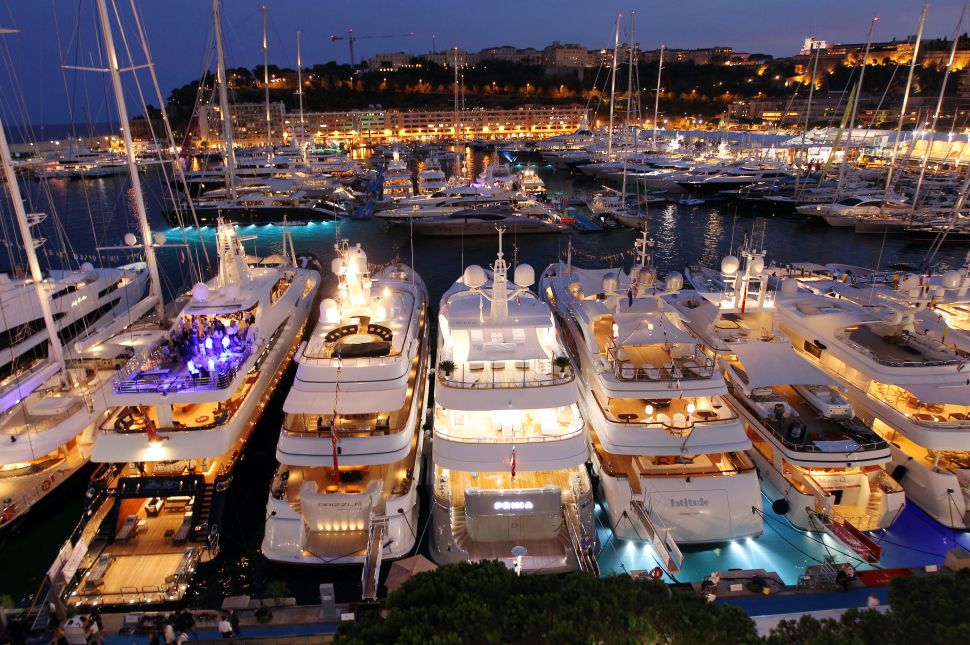
Yacht-setters, i.e. the maritime equivalent to jet-setters, circle the globe on mega yachts, the price tags of which can easily equal the yearly-budgets for a small nation. But don’t think it’s easy being rich — these gazillionairs have their yachting woes . The Biggie: when their mega yacht breaks down in a foreign port.
Sign Up For Our Daily Newsletter
Thank you for signing up!
By clicking submit, you agree to our <a rel="nofollow noreferer" href="http://observermedia.com/terms">terms of service</a> and acknowledge we may use your information to send you emails, product samples, and promotions on this website and other properties. You can opt out anytime.
I asked Sean Blue, Head of Global Watercraft for AIG Private Client Group (which represents the owners of more that 300 80-foot-plus super yachts worldwide), to tell me about mega yachts and their owners .
Who are the owners of super yachts? I can’t divulge our clients, but I can share that mega yacht owners include CEOs of Fortune 500 companies, captains of industry, entertainers, engineers, inventors, rulers, owners of manufacturing companies, billionaires, and generally people who are leaders in their fields. Mega yachts are generally defined as yachts greater than 100 feet or longer, all the way up to the current largest yacht in the world — AZZAM, which is 180.6 meters long (594 feet).
Tell me about the distances these yachts can navigate. This depends on the specifications of the yacht and what it was designed for . Some are not designed to travel long distances and instead are built for speed, or for local cruising, or with maybe enough range to make a trans-Atlantic crossing safely. But others are built with an incredible amount of range in mind and can travel some 8,000 nautical miles without refueling, while others are designed to explore arctic regions, or both. Circumnavigations are not uncommon and large yachts regularly make ocean transits — whether cruising from the Mediterranean to the Caribbean, or en route to Fiji across the Pacific. The only real limitations are time and money. And for most mega yacht owners, it’s just time.
Are these really ships — how do you differentiate a yacht from a ship? Some of them really are ships and are built that way, but the difference lies in how they are used. A yacht is a vessel built for the pleasure of her owner. The best yachts are built to commercial ship standards in terms of seaworthiness, safety, and technology; often times even a higher standard.
How about the price tag for these yachts? $1,000,000 a meter is the rule of thumb, but this can vary depending on the design, builder, systems, interiors and a great many other things. The largest yacht currently in the world, AZZAM, is reported to have cost over $700M to build. In addition to the yachts themselves are the interior décors and furnishings, wine collections, fine art collections, and its “toys” and tenders (support vessels).
What happens when a yacht breaks down on the other side of the globe? Mega yachts are managed and run by highly trained professionals from the captains and crews to the yacht managers that are often hired to manage all the aspects of owning and running a yacht. Not unlike the world of aviation, maintenance is ongoing, so an all-out breakdown on the water whereby you have a dead ship is a relatively rare occurrence. Fire aboard a yacht is actually a little more common, which is the primary source of large losses on yachts that AIG has seen, and something to which we pay a lot of attention by providing shipboard fire training for crews and local firefighters in seaside communities. Whether it’s a breakdown or a fire, after the initial response to save lives and property, the yacht may call for assistance from a neighboring ship or vessel and in some cases call a towing or salvage company for assistance to get the yacht back to the nearest safest port to evaluate damage and decide on next steps. That is usually when specialty insurers are called to facilitate the logistics and repairs.
What if it just needs work? Most of the work performed on a super yacht is performed by its crew. If there is need beyond that, specialists can be flown in from all around the world. Larger yachts are like big commercial buildings with air conditioning systems, watermakers, plumbing, electrical, hydraulics, refrigeration, and virtually any mechanical system you can imagine. If expertise is not available locally, you get the experts to come to you.
Where do they go for repairs? The best local place they can find that can address the yacht’s specific need. There are numerous facilities around the world that can accommodate and repair mega yachts, but as you get farther from the Western world, these facilities may not specialize or deal with yachts everyday and may be more directed toward commercial work and a more industrial level of care and finish quality. Often in these situations, repairs are made for the safety and seaworthiness of the yacht and cosmetics are handled at a later date at a facility specializing in the high level of yacht fitting and finish.
Does work need to be done on dry land? Some works can be accomplished while the yacht is in the water , even if it involves work to the bottom or propulsion or stabilizer equipment and that may sometimes be a safer and less expensive route if it’s feasible, but some maintenance and repair does require a haul out on land or dry dock.
How much does a typical yacht weigh? There really is not a typical yacht, and the weight can vary greatly. Yachts are generally measured in gross tonnage, which is a volumetric measurement. A yacht at the smaller end of the Mega Yacht segment, such as a 112-foot Westport, displaces 275,000 pounds and carries a gross tonnage of 207 gross tonnes. AZZAM, the largest yacht in the world, which is 590 feet long and was built by Lurssen in Germany, is reported to be over 13,000 gross tonnes.
Are there places in the U.S. that repair yachts? The U.S. is blessed with many great facilities around the country and on every coast that are capable of repairing and refitting yachts and mega yachts. Some are boat and ship yards that are also involved in building yachts, while some are mixed between private and commercial work, and others cater exclusively to the mega yacht community. South Florida is certainly an area of concentration for these facilities, but not the only region where one can find them.
Are there cranes capable of lifting these heavy yachts? Travel lifts can accommodate some pretty large yachts, but at a certain size, a dry-dock might be necessary and in these cases, this can certainly limit your options on where your yacht can be hauled and repaired.
An aside: Marine Group Boat Works in San Diego caters to mega yacht owners. Its six-story traveling crane is capable of lifting 665-tons. Each tire (there are 16) stands a foot taller than a grown man. The crane is said to be the strongest mobile crane in the U.S. It made record books when the 626 ton mega-yacht Ronin (previously owned by billionaire Larry Ellison – now owned by Venezuelan banker Victor Vargas ), became the largest private yacht ever to be lifted by a moving crane.

- SEE ALSO : Inside Observer’s Nightlife + Dining Power List Party: Hospitality’s Greats, Full-Circle Moments and Spicy Rigatoni
We noticed you're using an ad blocker.
We get it: you like to have control of your own internet experience. But advertising revenue helps support our journalism. To read our full stories, please turn off your ad blocker. We'd really appreciate it.
How Do I Whitelist Observer?
Below are steps you can take in order to whitelist Observer.com on your browser:
For Adblock:
Click the AdBlock button on your browser and select Don't run on pages on this domain .
For Adblock Plus on Google Chrome:
Click the AdBlock Plus button on your browser and select Enabled on this site.
For Adblock Plus on Firefox:
Click the AdBlock Plus button on your browser and select Disable on Observer.com.

The Low Down: Fresh Water On Board

This article is written with the dual aim of educating and preparing yacht Engineers, their Captains, Operators, Owners and Management Companies to best plan and comply with the regulations and good practice for the production, treatment, storage and testing of fresh water held on board a yacht.
The Background
Do you drink the fresh water that you make on board? If not, why not? Do you spend lots of money on bottled water adding to the plastic production and recycling problem? Mounting evidence suggests that fresh water made from sea water using a correctly maintained Reverse Osmosis Plant (RO plant) or even plain tap water may be better for you than some of the plethora of bottled waters available.
This will depend on the condition of the plant membranes and the storage tanks on your vessel but also where the water was made and what treatment systems are on board. Tap water in most countries is usually perfectly suitable and in some cases better than the bottled variety.

- Efficient 200/300
- WATER-PRO MODULAR

How Do Yachts Get Fresh Water?

Fresh water is undeniably an essential requirement on any sea voyage, even more so for long journeys on a yacht. This article provides an examination of how yachts maintain an uninterrupted supply of this vital resource while at sea. To learn more about the possible ways to achieve this feat and to get a better understanding of the underlying mechanics involved, stick with us till the end.
While on a yacht, gaining access to fresh water can impose a great deal of challenge, especially considering there's only seawater as far as the eye can see. There is, however, primary technology that has proven successful in turning this tide. Let's dive in to find out more about this ingeniously impressive method.
Desalination through Reverse Osmosis
The answer to the mystery of 'how yachts procure fresh water' is primarily based in desalination, specifically with a focus on reverse osmosis. This is a system that quite literally transforms seawater into drinkable water. To better grasp the essence of reverse osmosis, it's the process where high-pressure pumps are used to fight against osmotic pressure.
Once the seawater is pumped into the system with high pressure, it goes through a series of filters. The end result is drinkable water completely free of any salts or other impurities. However, one should note that the operation of these machines requires a considerable amount of energy.
Lastly, the benefit of onboard desalination through reverse osmosis is its efficiency and potential for sizable production. Desalination systems come in various sizes that can be selected depending on the yacht’s needs. For instance, with the right machinery, it is possible to generate up to 4000 litres of fresh water per hour.
Storing and Conserving Water
Obtaining fresh water is only one side of the coin; storing and conserving it is equally important on a yacht. Many boats have a system of internal freshwater tanks that are filled before departure. But these resources can deplete quickly depending on consumption, hence the importance of prudent usage and adequate conservation measures.
Potential conservation methods can include installing faucets that operate using foot or knee levers to reduce wastage and adopting water-saving appliances like efficient dishwashers or washing machines. Incorporating simple practices like these can significantly reduce freshwater consumption on board.
Moreover, rainwater collection is another potential method of sourcing fresh water, which, while primarily used in emergency situations or when at anchor, could supplement onboard supplies.
Maintaining Water Quality
Ensuring the quality of the onboard freshwater supply is another critical aspect. Regular maintenance and sanitization of systems, filters, and storage tanks are of utmost necessity. Moreover, it is advisable to regularly test the water for any potential contamination, ensuring the health and safety of those on board.
In the case of reverse osmosis systems, routine maintenance may involve filter replacements and system checks to ensure optimal functioning and water quality. Furthermore, it is important to remember that while this process does remove salts and impurities, it does not necessarily remove all potential bacteria, thus additional purification steps may be needful depending on the source water.
In Conclusion
In summary, ensuring a steady supply of fresh water on a yacht involves a synthesis of innovative technology like reverse osmosis desalination and practical habits for conserving and maintaining water quality. These systems and practices collectively ensure that voyagers have access to the essential supply of freshwater during their sea journeys.
Taking a step further, why not consider investing in a marine watermaker to take care of your fresh water needs on your next yachting expedition? With our state-of-the-art technology, you can transform seawater into potable water, anytime, anywhere. Get a free quote for a marine watermaker today and set sail with confidence knowing your freshwater needs are well taken care of.

Darryl Massey is a seasoned expert in reverse osmosis watermaker technology, with a keen focus on sustainable solutions. With over two decades at EcoSistems, Darryl combines deep technical knowledge and a commitment to innovation, contributing to the development of energy-efficient systems. His expertise ensures advanced, reliable solutions in water purification for clients across the globe.
WATERMAKERS
Sailboat Watermarker
Yacht Watermarker
Boat Watermarker
Reverse Osmosis Watermarker
Watermarker Machine
Marine Watermarker
DESALINATION
Sea water dasalination device
Desalination plant
Reverse osmosis desalination system
Reverse osmosis desalination machine
Reverse osmosis filter
Desalination machine for boat
Reverse osmosis desalination for boats
Desalination machine for sail boat
Desalination machine for yacht

How Do Sailboats Get Fresh Water? (4 EFFECTIVE SOLUTIONS)

Sailors know that having access to fresh water is essential for a safe and comfortable journey out at sea. But how do they get this water? Fortunately, there are several ways for sailors to get fresh water while out at sea. In this article, well explore four effective solutions: watermakers, collecting rainwater, using jerry cans, and using a water filter. Well also discuss the benefits of having fresh water at sea and the safety precautions to take. So, if youre planning a sailing adventure, read on to find the best way to get fresh water for your trip!
Table of Contents
Short Answer
Most sailboats get their fresh water from onboard tanks that they fill up from dockside water sources.
They can also use desalination systems to take salt out of seawater and make it drinkable.
Boats that are moored in marinas may be able to get fresh water from the marina itself.
Some sailboats also have large water containers that they fill up from a hose or a freshwater source on shore.
What is a Watermaker
A watermaker is a device that is used to convert saltwater into freshwater, making it an essential tool for sailors who are out at sea for extended periods of time.
The device works by taking in saltwater, filtering it, and then using a process called reverse osmosis to extract the salt from the water.
The device then produces freshwater that is safe to drink and use for cooking.
This process helps ensure that sailors have access to freshwater even when they are far away from land.
Some watermakers are powered by a boats engine, while others are powered by an auxiliary electric motor.
In addition, many modern watermakers are equipped with advanced features such as automated operation, corrosion-resistant materials, and low-maintenance designs.
Collecting Rainwater

One of the most effective solutions for sailboats to get fresh water is by collecting rainwater.
Sailors can use a variety of methods to collect rainwater and store it on board.
These include using a tarp to collect rainwater, using a rainwater catchment system to collect and store large amounts of water, or using a container to collect smaller amounts.
Collecting rainwater is a great way to get fresh water without having to rely on a watermaker or other more expensive methods.
When collecting rainwater, it is important to make sure that the water is clean and free of contaminants.
Sailors can ensure this by covering the tarp or catchment area with a material such as a boat cover to keep out dirt and debris, or by using a filter to eliminate any larger particles from the collected water.
With the right setup, sailors can use rainwater to supply their fresh water needs while on board.
In addition to providing an easy and cost-effective way to get fresh water, collecting rainwater is also a great way to save on fuel costs.
Collecting rainwater requires no fuel, and can help sailors to conserve their fuel resources while at sea.
All in all, collecting rainwater is an efficient, cost-effective, and environmentally friendly way for sailboats to get fresh water.
With the right setup, sailors can easily collect and store large amounts of fresh water while on board.
Using Jerry Cans
Using jerry cans to transport water from land is a popular method for sailboats to get fresh water.
Jerry cans are large, airtight containers that are designed to withstand the harsh conditions of the sea.
They come in various sizes, and can hold up to 20 gallons of water.
This makes them ideal for sailboats, as they can be easily loaded onto the boat and transported to the open seas.
When using jerry cans, its important to ensure that the cans are properly sealed to prevent any saltwater from getting in.
Additionally, its important to check the cans regularly for signs of wear and tear.
If any cracks or holes are found, its best to replace the container as soon as possible to ensure safe and clean water.
Once the jerry cans are full of water, they can be easily loaded onto the sailboat.
This method of obtaining fresh water is great for sailors that are close to land and can easily access a source of freshwater.
Its also a great way to stock up on water for longer voyages, as the cans can be loaded up and stored on the boat until needed.
Overall, using jerry cans to transport water from land is a great way for sailboats to get fresh water.
Its a relatively simple process and can provide sailors with a reliable source of freshwater.
As long as the containers are properly sealed and checked regularly, they can provide sailors with all the fresh water they need for a successful voyage.
Using a Water Filter

Using a water filter is a great way for sailboats to get fresh water while they are out on the open sea.
A water filter is a device used to remove impurities from water, such as dirt, bacteria, and other contaminants.
Not only is this a cost-effective way to get fresh water, but it is also a safe and reliable option.
When using a water filter, you can either choose to attach the filter directly to the side of the boat, or you can use a portable filter.
The filter works by collecting water from a river, lake, or stream and filtering out any impurities.
The filtered water is then delivered to the boat and can be used for drinking, cooking, and other activities.
There are many different types of water filters available, depending on your needs.
Some filters are designed to remove bacteria and other contaminants, while others are designed to remove heavy metals and pesticides.
When choosing a filter, it is important to consider the type of water you will be filtering, the amount of water you will need, and the size of the filter.
One of the advantages of using a water filter is that you can filter water from any source, making it a great option for sailboats.
Additionally, water filters do not require a large amount of electricity, making them an ideal choice for sailboats.
Not only is it cost-effective, but it is also safe and reliable.
With a variety of filters available, you can be sure to find a filter that meets your needs.
Desalinators
When it comes to getting fresh water while sailing, desalinators are one of the most reliable and effective solutions.
A desalinator is a machine that converts seawater into fresh water.
It works by using a process called reverse osmosis, which filters out salt and other impurities from the seawater and produces freshwater as a result.
Desalinators can be powered by electricity, or they can be powered by the boats engine, making them flexible and convenient.
Desalinators are often used in boats that are sailing in areas with limited access to freshwater sources, such as the ocean.
They are also often used in emergency situations, as they can provide a reliable and safe supply of freshwater in the absence of other options.
Desalinators are also typically more efficient than other methods of obtaining freshwater.
They use a relatively small amount of energy to produce a large amount of freshwater, making them cost-effective and efficient.
Additionally, they require minimal maintenance, making them a great option for sailors who want a reliable source of freshwater while at sea.
The only downside to desalinators is that they can be expensive to purchase and install.
However, if you are a sailor who needs a reliable and consistent source of freshwater while sailing, a desalinator is likely your best bet.
Benefits of Fresh Water at Sea

Having access to fresh water while sailing at sea is essential for the safety and comfort of the crew aboard.
Not only does fresh water provide the essential hydration needed to sustain life, but it also helps to keep the boat and its occupants clean and healthy.
Fresh water can be used for cooking, washing dishes, showering, and laundry, and it can also be used to replenish drinking water supplies.
Having access to fresh water also helps to reduce the risk of dehydration and other health risks associated with drinking saltwater.
Finally, having access to fresh water can help to reduce the risk of running out of supplies while out at sea, as fresh water can be used to refill drinking water tanks and other vessels.
Safety Precautions
When it comes to getting fresh water for a sailboat, it is important to take safety precautions.
This is especially true when dealing with water from rivers, streams, or lakes, as these sources may contain harmful bacteria or other contaminants.
It is also important to practice safe water storage and transportation techniques when collecting water from jerry cans.
Boats should also be equipped with the necessary safety equipment, such as life rafts and life jackets, in case of emergencies.
Additionally, boat owners should make sure that their boat is properly equipped with all necessary navigation and communication equipment, as well as the necessary safety gear.
Finally, all crew members should be trained in how to properly handle and store the water they collect.
This will ensure that everyone is safe and that the water is handled with the utmost care.
Final Thoughts
Having access to fresh water while at sea is essential for a successful sailing journey.
All of the solutions discussed here have their own advantages and disadvantages, so it’s important to assess your situation and choose the best option for you.
Whether you choose to use a watermaker, collect rainwater, use jerry cans, use a water filter, or employ desalinators, you’ll be able to ensure that you have the fresh water you need to stay safe and comfortable while sailing.
James Frami
At the age of 15, he and four other friends from his neighborhood constructed their first boat. He has been sailing for almost 30 years and has a wealth of knowledge that he wants to share with others.
Recent Posts
Does Your Boat License Expire? Here's What You Need to Know
Are you a boat owner looking to stay up-to-date on your license requirements? If so, youve come to the right place! In this article, well cover everything you need to know about boat license...
How to Put Skins on Your Boat in Sea of Thieves? (Complete Guide)
There is a unique sense of pride and accomplishment when you show off a boat you customized to your exact specifications. With Sea of Thieves, you can customize your boat to make it look like your...
Yacht Dreaming
Where Do Yachts Get Their Fresh Water From?

With the abundance of luxury yachts in the market, it can be difficult to decide which one is the best for you. But don’t worry, we’ve got you covered. We’ve done the research and compiled a list of the top 5 luxury yachts in the world – Feadship, Lurssen, Oceanco, Benetti, and Christensen – that offer the ultimate in comfort, style, and performance. Sit back, relax, and let us help you find the perfect luxury yacht for your next sail.
The Best Luxury Yachts
If you’re looking for the perfect yacht, you won’t find a better selection than the best luxury yachts in the world. From Feadship to Lurssen, Oceanco, Benetti and Christensen, you can’t go wrong.
These top-notch companies provide top-of-the-line features, performance and style, allowing you to make a statement on the water. Whether you’re looking for speed and power or luxurious accommodations, you’ll be sure to find the yacht of your dreams with one of these companies.
You won’t have to worry about settling for a sub-par yacht either. The best luxury yachts are equipped with top-tier amenities, from advanced navigation systems to a fully-stocked galley and even onboard spas. Whether you’re looking for an intimate getaway or a gathering place for friends and family, these yachts are sure to exceed your expectations.
With the highest quality materials and craftsmanship, you can rest assured knowing you’re in good hands. If you’re looking for an unforgettable experience, look no further than the best luxury yachts in the world.
Feadship is arguably one of the best luxury yachts in the world. Known for its superior craftsmanship, Feadships are the perfect combination of power, stability, speed, and comfort. With sleek lines, timeless style, and top-notch amenities, these luxury yachts can provide guests with one of the most luxurious yachting experiences available.
Whether you’re looking to cruise around the Mediterranean or explore the Caribbean, Feadship is sure to deliver. And with the latest technology and a wide range of choices, you can customize your yacht to fit your exact needs. So if you’re looking for a luxurious and luxurious yacht, Feadship is your go-to option.
Lurssen is a great option if you are looking for a top-of-the-line luxury yacht. The German-based shipyard produces some of the best yachts in the world, with sleek designs, beautiful interiors and state-of-the-art features. They have over 130 years of experience in the industry, and their award-winning designs have been featured in numerous magazines and publications.
Their vessels come with the highest safety standards, meaning you can sail with confidence.
If you are after an opulent and stylish yacht that is unmatched in terms of performance and quality, then Lurssen should be your go-to. Luxury comes as standard with a Lurssen yacht, and they have a wide range of options available to suit your needs. From sleek motor yachts and sailing yachts to classic superyachts and expedition vessels, you are sure to find something that is perfect for your needs.
The company offers custom-built vessels, so you can create a yacht that is truly unique and personalized. In conclusion, Lurssen is a great choice if you are looking for a luxury yacht that combines elegance, performance and quality.
With decades of experience and award-winning designs, you can be sure that you will be getting a vessel that is second to none. Whether you are after a sleek motor yacht or a classic superyacht, you can be sure that Lurssen will provide a vessel that you can be proud of.
If you’re looking for a truly luxurious yacht, then look no further than Oceanco. The company has been building some of the world’s most spectacular yachts since 1990, and their attention to detail and craftsmanship are unparalleled. From their sleek, modern designs to their expertly crafted interiors, Oceanco’s yachts are sure to impress.
Whether you’re looking for a yacht for a weekend cruise or something to serve as your primary residence, you’ll be spoilt for choice with an Oceanco.
You’ll also benefit from their extensive experience in the industry, with advanced navigation systems, state-of-the-art propulsion systems, and luxurious amenities to keep you entertained. The advanced engineering and construction methods mean you can count on your yacht to be reliable and safe. If you’re looking for a one-of-a-kind experience, then Oceanco is the way to go.
The custom designs mean you can choose the style and amenities that best fit your needs.
With an interior designer and an experienced crew to ensure your yacht is just as you envisioned, you can create a truly unique experience. From the stunning artwork and plush furnishings to the custom-built amenities and modern technology, you’ll be amazed by the possibilities.
And with a wide variety of sizes and designs, you’re sure to find something that matches your lifestyle. At the end of the day, Oceanco offers some of the best luxury yachts in the world. You can trust that you’re getting quality, style, and performance with every yacht they make.
With their vast experience and expertise in the industry, you can be sure that you’re getting a boat that will last for years to come. So if you’re looking for the best of the best in luxury yachts, then look no further than Oceanco.
If you’re looking for a luxurious and iconic yacht, then Benetti should be at the top of your list. Benetti yachts are renowned for their classic, timeless design and superior quality craftsmanship. The interiors are spacious and inviting, with exquisite finishes and fittings that make them a true delight to cruise aboard.
They feature stylish and comfortable cabins, as well as a wide range of state-of-the-art amenities that allow you to travel in luxury and style. Benetti yachts are also renowned for their performance on the open sea, ensuring smooth sailing and an enjoyable experience. With the added bonus of a highly skilled and experienced crew , Benetti creates an exceptional experience for all who sail aboard them.
Christensen
Christensen is the perfect yacht for those who truly value luxury and high performance. Its sleek design allows for impressive maneuverability and speed without sacrificing comfort.
With its state-of-the-art custom interiors and modern amenities, Christensen is the ultimate in luxury yachting. From its luxurious bedrooms and stunning dining areas to its expansive decks and lounges, Christensen offers exquisite style and sophistication.
With its world-class navigation and communications systems, Christensen allows you to explore the world in total comfort and security. Whether you’re looking for a romantic getaway or an adventure-filled voyage, Christensen is the ideal choice for a luxury yacht experience.
Christensen yachts are renowned for their cutting-edge technology and engineering. The company’s proprietary engineering process allows for precise customizations, ensuring that each yacht is a perfect blend of performance and luxury.
Christensen yachts feature a variety of advanced features, such as automated navigation systems and advanced entertainment systems. Their advanced engineering also ensures that they are able to handle any weather conditions, giving you the freedom to explore wherever you desire.
Whether you’re looking for a classic sailing experience or a luxurious cruise, Christensen offers the best in luxury yachting. With its cutting-edge technology, unrivaled comfort, and exquisite style, Christensen is the perfect choice for the discerning yachting enthusiast. From its luxurious amenities to its unparalleled performance, Christensen is the ideal choice for an unforgettable luxury yacht experience.
When it comes to luxury yachts, there are a few brands that stand out from the rest. Lurssen, Oceanco, Benetti, and Christensen all offer the pinnacle of comfort, style, and performance. While the decision of which luxury yacht is best depends on your own preferences, these are the brands you should keep in mind when searching for the ultimate in luxury boats.
If you’re looking for a top-of-the-line yacht, you can’t go wrong with one of these five brands.
Each offers its own unique combination of performance and luxury, so it’s important to do your research and find the one that best suits your needs. Whether you’re looking for a large yacht for entertaining or a smaller one for cruising, you can trust these brands to provide you with the best experience possible. Go ahead and start your search for the perfect luxury yacht today!
What Are the Benefits of Owning a Yacht in BC?
Why Does a Boat Float: Uncovering the Science Behind Yachting
© 2024 Yacht Dreaming


IMAGES
VIDEO
COMMENTS
A typical superyacht desalination system can produce anywhere from 1,500 to 35,000 liters of fresh water per day, depending on the size of the yacht and the system's capacity. Desalination systems are also becoming more advanced and efficient. Many superyachts now use energy recovery devices that harness the pressure from the saltwater to power ...
Freshwater systems are relatively straightforward and not too difficult to maintain if you understand a few basics. On small boats, a system can be as simple as a tank and a pump that comes on when a faucet is opened. Systems on most yachts, though, are a little more involved. They consist of one or more tanks, often with level monitors ...
To regulate water flow and pressure, yacht water distribution systems are equipped with control valves that can be adjusted as needed. Yacht Water Pumps: Yacht water pumps play a crucial role in moving the water from the storage tanks to the different outlets on the yacht. These pumps are available in both electric and manual variants ...
Yachts typically have fresh water on board through a combination of storage tanks, watermakers, and shore connections. Freshwater storage tanks are built into the yacht's structure and can hold a certain capacity of water. One of the ways that yachts get access to fresh water is by filling up water tanks when the boat is docked.
A high-pressure pump pushes seawater through a semi-permeable membrane that filters out salt, organics, and bacteria. The fresh water is pumped into your water tanks while the remaining brine bi-product is discharged over the side of the boat, back into the ocean. Schematic of a Rainman watermaker system. Photo credit: Rainman.
Yachts have plumbing systems too. Pipes, valves, pumps, and filters all play a role in maintaining proper water flow. Regular maintenance and inspection are necessary to detect any leaks or blockages. Stay informed to make the most of your yachting experience. We will provide expert advice and tips.
If you use, 30 gallons per day and you want to desalinate for three hours every day, you'll need a 10 gallon-per-hour watermaker, or 240 gallons per day, to keep the tanks topped up. But a 400-gallons-per-day model, making 16 gallons per hour, will let you desalinate every other day for just less than four hours.
The 80-foot Invictus promises to be the first of a new generation of freshwater superyachts. Bravada Yachts. Companies in Australia and Germany are also launching new glass-centric freshwater ...
The EXPRESS CLEARMATE combines two of Blue Water Desalination's efficient watermaker systems into one convenient package. This compact unit produces ultra-pure water from either seawater or dock water with the touch of a button. Rated production from seawater ranges from 750 to 1,800 GPD (2,480 LPD to 6,810 LPD) and from 1,000 to 2,600 GPD ...
The top tip from many skippers was to install a saltwater pump in the galley and heads. "Seawater can be used in all sinks on board," declared the crew of XC42 Euphoria. "Shut down the pumps ...
The most common way of obtaining freshwater is to use onboard water tanks, which can be filled at dockside water supplies. However, yachts can also use onboard water makers, collect rainwater, or use the water produced by onboard generators and engines. Regardless of the method used, yachts must be sure to have a reliable source of fresh water ...
These systems are essential for long voyages, particularly those that take place in remote areas where fresh water is scarce. A typical superyacht desalination system can produce anywhere from 1,500 to 35,000 liters of fresh water per day, depending on the size of the yacht and the system's capacity.
The company's production is very wide-ranging: Osmosea produces not only watermakers but also complete systems for converting and purifying fresh water into drinking water, which can be drunk directly from tanks, almost completely eliminating the use of plastic on board. This small system, which can be installed on any type of boat, generally comes with the purchase of the traditional or ...
Our survey of the Atlantic Rally for Cruisers (ARC) fleet last year focused on water. We asked the skippers how much water they carried for sailing, in what form, how it was used and, for the ...
How do big or mega yachts get fresh water? Big size or superyachts need to be able to produce their own fresh water through desalination. Hence, having a yacht watermaker (also known as reverse osmosis desalination systems) on board is a huge advantage because of the reduced need to have large, heavy water tanks on board for long charters.
Mega yachts are generally defined as yachts greater than 100 feet or longer, all the way up to the current largest yacht in the world — AZZAM, which is 180.6 meters long (594 feet). Tell me ...
Treatment. Water made on board is usually tested automatically for salt content by a device called a salinometer. This measures the salt content by electrical conductivity and is measured in micro-siemens. It will alarm if the salt level is too high and the product water is then dumped overboard. Since the quality of the water is controlled by ...
Obtaining fresh water is only one side of the coin; storing and conserving it is equally important on a yacht. Many boats have a system of internal freshwater tanks that are filled before departure. But these resources can deplete quickly depending on consumption, hence the importance of prudent usage and adequate conservation measures.
Shore Connection: When a yacht is docked in a marina or port, it can connect to a shore water supply. This allows the yacht to directly access a freshwater source available on land, typically ...
One of the most effective solutions for sailboats to get fresh water is by collecting rainwater. Sailors can use a variety of methods to collect rainwater and store it on board. These include using a tarp to collect rainwater, using a rainwater catchment system to collect and store large amounts of water, or using a container to collect smaller ...
All SILENT-YACHTS are equipped with a water maker, which processes sea water into fresh water. ...
How do we get fresh water on a sailboat in remote areas and when we're on long passages out to sea? There are actually a few different ways, some easier and...
But don't worry, we've got you covered. We've done the research and compiled a list of the top 5 luxury yachts in the world - Feadship, Lurssen, Oceanco, Benetti, and Christensen - that offer the ultimate in comfort, style, and performance. Sit back, relax, and let us help you find the perfect luxury yacht for your next sail.